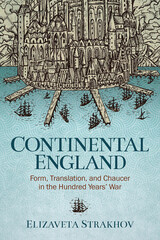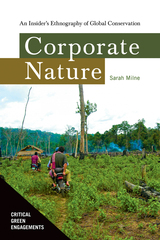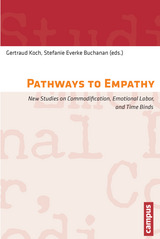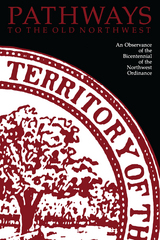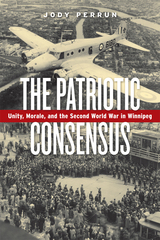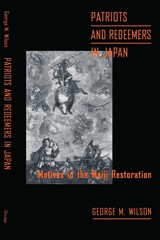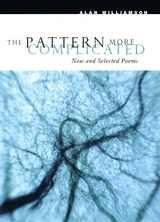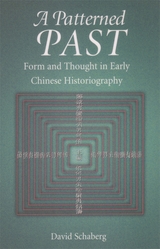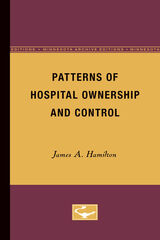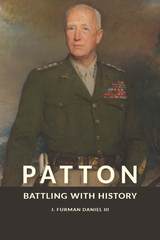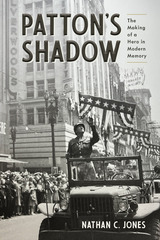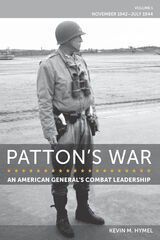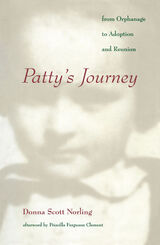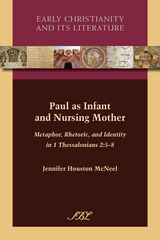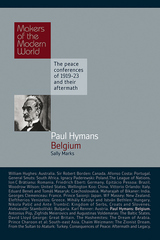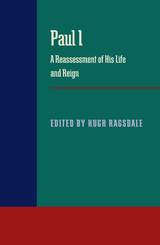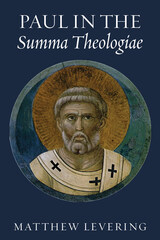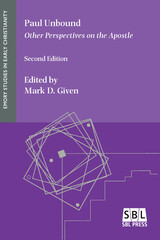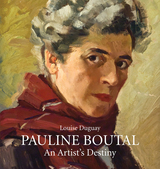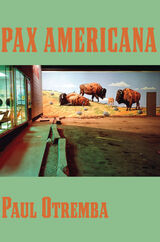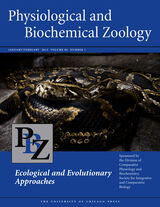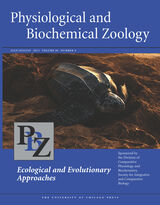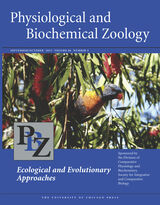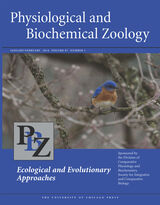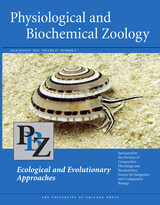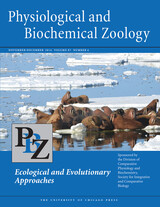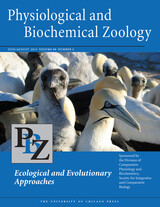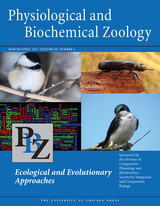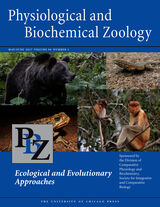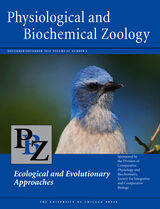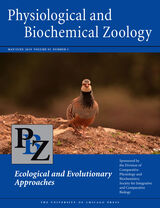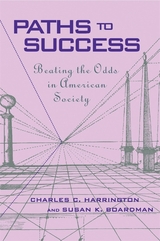 Paths to Success: Beating the Odds in American Society
Charles Harrington and Susan K. Boardman
Harvard University Press, 2000 Who would have thought that Joycelyn Elders, born into a family that chopped cotton and trapped raccoons to survive, would grow up to be Surgeon General of the United States? Or that Clarence Thomas, brought up by his barely literate grandfather, would someday be a Justice of the Supreme Court? Certainly not statisticians, who tell us that impoverished backgrounds are fairly accurate predictors of impoverished futures. This book seeks out the stories behind the exceptions: those who, against all odds, have made the American myth of rags-to-riches a reality.
For more than ten years Charles Harrington and Susan Boardman explored the life histories of successful Americans forty to fifty-five years old--those from poor homes, whose parents had not completed high school, and those from the middle class. Comparing the routes to success of these two groups--the one by various courses of their own construction, the other by a well-laid path--the authors are able to show where their efforts and qualities diverge, and where they coincide.
Joycelyn Elders and Clarence Thomas are examples of the "pathmakers" of this work. While Paths to Success reveals certain consistencies between these pathmakers' approaches and those of their middle-class counterparts, it also exposes striking differences between men and women, blacks and whites. These differences, fully described here, illuminate the ways in which opportunities, serendipities, and impediments intersect with personal resources, strategies, and choices to produce success where we least expect it.
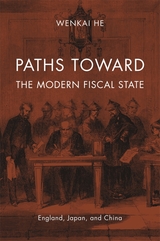 Paths toward the Modern Fiscal State: England, Japan, and China
Wenkai He
Harvard University Press, 2013 The rise of modern public finance revolutionized political economy. As governments learned to invest tax revenue in the long-term financial resources of the market, they vastly increased their administrative power and gained the ability to use fiscal, monetary, and financial policy to manage their economies. But why did the modern fiscal state emerge in some places and not in others? In approaching this question, Wenkai He compares the paths of three different nations—England, Japan, and China—to discover why some governments developed the tools and institutions of modern public finance, while others, facing similar circumstances, failed to do so.
Focusing on three key periods of institutional development—the decades after the English Civil Wars, the Meiji Restoration, and the Taiping Rebellion—He demonstrates how each event precipitated a collapse of the existing institutions of public finance. Facing urgent calls for revenue, each government searched for new ways to make up the shortfall. These experiments took varied forms, from new methods of taxation to new credit arrangements. Yet, while England and Japan learned from their successes and failures how to deploy the tools of modern public finance and equipped themselves to become world powers, China did not. He’s comparative historical analysis isolates the nature of the credit crisis confronting each state as the crucial factor in determining its specific trajectory. This perceptive and persuasive explanation for China’s failure at a critical moment in its history illuminates one of the most important but least understood transformations of the modern world.
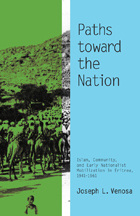 Paths toward the Nation: Islam, Community, and Early Nationalist Mobilization in Eritrea, 1941–1961
Joseph L. Venosa
Ohio University Press, 2014 In the early and mid-1940s, during the period of British wartime occupation, community and religious leaders in the former Italian colony of Eritrea engaged in a course of intellectual and political debate that marked the beginnings of a genuine national consciousness across the region. During the late 1940s and 1950s, the scope of these concerns slowly expanded as the nascent nationalist movement brought together Muslim activists with the increasingly disaffected community of Eritrean Christians. The Eritrean Muslim League emerged as the first genuine proindependence organization in the country to challenge both the Ethiopian government’s calls for annexation and international plans to partition Eritrea between Sudan and Ethiopia. The league and its supporters also contributed to the expansion of Eritrea’s civil society, formulating the first substantial arguments about what made Eritrea an inherently separate national entity. These concepts were essential to the later transition from peaceful political protest to armed rebellion against Ethiopian occupation. Paths toward the Nation is the first study to focus exclusively on Eritrea’s nationalist movement before the start of the armed struggle in 1961.
 The Pathway for Oxygen: Structure and Function in the Mammalian Respiratory System
Ewald R. Weibel, M.D.
Harvard University Press, 1984 It is rare indeed for one book to be both a first-rate classroom text and a major contribution to scholarship. The Pathway for Oxygen is such a book, offering a new approach to respiratory physiology and morphology that quantitatively links the two. Professionalism in science has led to a compartmentalization of biology. Function is the domain of the physiologist, structure that of the morphologist, and they often operate with vastly disparate concepts and procedures. Yet the performance of the respiratory system depends both on structural and on functional properties that cannot be separated.
The first chapter of The Pathway for Oxygen engages the student with the design and function of the vertebrate respiratory organs from a comparative viewpoint. The second chapter adds to that foundation the link between cell energetics and oxygen needs of the whole animal. With Chapter 3 the excitement begins—new ideas, fresh attacks on old problems, and a fuller account of the power of the quantitative approach Dr. Ewald Weibel has pioneered.
The Pathway for Oxygen will be read eagerly by medical students, graduate students, advanced undergraduates in zoology—and by their professors.
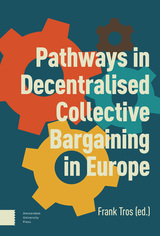 Pathways in Decentralised Collective Bargaining in Europe
Frank Tros
Amsterdam University Press, 2023 One of the main challenges in labour relations in Europe is the ongoing decentralisation of collective bargaining from national and sectoral levels to company levels. Decentralisation might be an answer to business needs in competitiveness and organisational flexibility. However, it risks erosion of collective bargaining structures, more inequality in employment conditions and fragmentation in trade unions’ powers.
Based on recent qualitative research, this book shows high varieties across European countries and economic sectors in degrees, forms and impacts of decentralisation. The authors explore, in interdisciplinary and multi-level perspectives, continuity and change in regulating and practicing collective bargaining in France, Germany, Ireland, Italy, the Netherlands, Poland, Spain and Sweden. In cross-country comparisons, company case studies in manufacturing and retail show the divergent effects of national regimes and social partners’ power resources on trade unions’ strategies and influence in company bargaining.
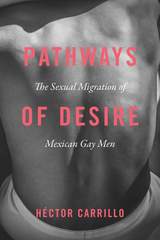 Pathways of Desire: The Sexual Migration of Mexican Gay Men
Héctor Carrillo
University of Chicago Press, 2017 With Pathways of Desire, Héctor Carrillo brings us into the lives of Mexican gay men who have left their home country to pursue greater sexual autonomy and sexual freedom in the United States. The groundbreaking ethnographic study brings our attention to the full arc of these men’s migration experiences, from their upbringing in Mexican cities and towns, to their cross-border journeys, to their incorporation into urban gay communities in American cities, and their sexual and romantic relationships with American men. These men’s diverse and fascinating stories demonstrate the intertwining of sexual, economic, and familial motivations for migration.
Further, Carrillo shows that sexual globalization must be regarded as a bidirectional, albeit uneven, process of exchange between countries in the global north and the global south. With this approach, Carrillo challenges the view that gay men from countries like Mexico would logically want to migrate to a “more sexually enlightened” country like the United States—a partial and limited understanding, given the dynamic character of sexuality in countries such as Mexico, which are becoming more accepting of sexual diversity. Pathways of Desire also provides a helpful analytical framework for the simultaneous consideration of structural and cultural factors in social scientific studies of sexuality. Carrillo explains the patterns of cross-cultural interaction that sexual migration generates and—at the most practical level—shows how the intricacies of cross-cultural sexual and romantic relations may affect the sexual health and HIV risk of transnational immigrant populations.
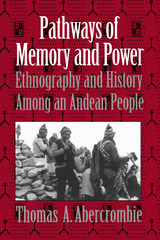 Pathways of Memory and Power: Ethnography and History among an Andean People
Thomas A. Abercrombie
University of Wisconsin Press, 1998 Pathways of Memory and Power crosses the disciplinary boundary where anthropology and history meet, exploring the cultural frontier of the colonial and postcolonial Andes. Thomas A. Abercrombie uses his fieldwork in the Aymara community of Santa Barbara de Culta, Bolivia, as a starting point for his ambitious examination of the relations between European forms of historical consciousness and indigenous Andean ways of understanding the past. Writing in an inviting first-person narrative style, Abercrombie confronts the ethics of fieldwork by comparing ethnographic experience to the power-laden contexts that produce historical sources.
Making clear the early and deep intermingling of practices and world views among Spaniards and Andeans, Christians and non-Christians, Abercrombie critiques both the romanticist tendency to regard Andean culture as still separate from and resistant to European influences, and the melodramatic view that all indigenous practices have been obliterated by colonial and national elites. He challenges prejudices that, from colonial days to the present, have seen Andean historical knowledge only in mythic narratives or narratives of personal experience. Bringing an ethnographer’s approach to historiography, he shows how complex Andean rituals that hybridize European and indigenous traditions—such as libation dedications and llama sacrifices held on saints’ day festivals—are in fact potent evidence of social memory in the community.
 Pathways of Power: The Dynamics of National Policymaking
Timothy J. Conlan, Paul L. Posner, and David R. Beam
Georgetown University Press, 2014 While civics textbooks describe an idealized model of “how a bill becomes law;” journalists often emphasize special interest lobbying and generous campaign contributions to Congress; and other textbooks describe common stages through which all policies progress, these approaches fail to convey—much less explain—the tremendous diversity in political processes that shape specific policies in contemporary Washington. Bridging the gap between textbook models of how public policy should work, and how the process actually works in contemporary Washington, Pathways of Power provides a framework that integrates the roles of political interests and policy ideals in the contemporary policy process. This book argues that the policy process can be understood as a set of four distinctive pathways of policymaking—pluralist, partisan, expert, and symbolic—that draw upon different political resources, appeal to different political actors, and elicit unique strategies and styles of coalition building. Revealing the strategic behavior of policy actors who compete to shift policies onto pathways that maximize their resources and influence, the book provides a fresh approach to understanding the seeming chaos and volatility of the policy process today. The book’s use of a wide universe of major policy decisions and case studies, focused on such key areas as health care, federal budgeting, and tax policy, provides a useful foundation for students of the policy process as well as for policy practitioners eager to learn more about their craft.
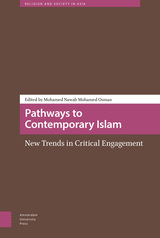 Pathways to Contemporary Islam: New Trends in Critical Engagement
Mohamed Nawab Mohamed Osman
Amsterdam University Press, 2020 Pathways to Contemporary Islam: New Trends in Critical Engagement highlights that the current tensions in Islam and the Muslim world are the result of historical dynamics as opposed to an alleged incompatibility between religious tradition and modernity. The emphasis on pathways indicates that critical engagement and contestation have always been intrinsic to the history of Islam. The aim of the book is to elaborate the contemporary pathways and analyse the trends that contest the Islamic intellectual tradition, the relationship between religion and politics, and the individual and collective practice of religion. The collection of essays analyses the current efforts of critical re-engagement with the Islamic intellectual tradition and underlines the historical diversity of Islamic orthodoxies that led to the establishment of various pathways in the practice and role of religion in Muslim societies.
Pathways to Empathy: New Studies on Commodification, Emotional Labor, and Time Binds
Edited by Gertraud Koch and Stefanie Everke Buchanan
Campus Verlag, 2013 Three decades after the publication of Arlie Russell Hochschild’s The Managed Heart, the processes of commodification of emotion she wrote about now reach into all areas of labor processes, extending even to private life and intimate relationships. The contributors to this volume take up her concepts to study the diversity of this economic intrusion into family, education, and nursing in the service sector as well as into corporate management. Aside from the powers and interests that force these developments, these essays argue, there are also productive uses and active resistances to them.
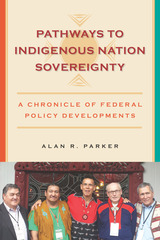 Pathways to Indigenous Nation Sovereignty: A Chronicle of Federal Policy Developments
Alan R Parker
Michigan State University Press, 2018 In a story that could only be told by someone who was an insider, this book reveals the background behind major legislative achievements of U.S. Tribal Nations leaders in the 1970s and beyond. American Indian attorney and proud Chippewa Cree Nation citizen Alan R. Parker gives insight into the design and development of the public policy initiatives that led to major changes in the U.S. government’s relationships with Tribal Nations. Here he relates the history of the federal government’s attempts, beginning in 1953 and lasting through 1965, to “terminate” its obligations to tribes that had been written into over 370 Indian treaties in the nineteenth century. When Indian leaders gathered in Chicago in 1961, they developed a common strategy in response to termination that led to a new era of “Indian Self-Determination, not Termination,” as promised by President Nixon in his 1970 message to Congress. Congressional leaders took up Nixon’s challenge and created a new Committee on Indian Affairs. Parker was hired as Chief Counsel to the committee, where he began his work by designing legislation to stop the theft of Indian children from their communities and writing laws to settle long-standing Indian water and land claims based on principles of informed consent to negotiated agreements. A decade later, Parker was called back to the senate to work as staff director to the Committee on Indian Affairs, taking up legislation designed by tribal leaders to wrest control from the Bureau of Indian Affairs over governance on the nation’s 250 Indian reservations and negotiating agreements between the tribes that led to the Indian Gaming Regulatory Act. A valuable educational tool, this text weaves together the ideas and goals of many different American Indian leaders from different tribes and professional backgrounds, and shows how those ideas worked to become the law of the land and transform Indian Country.
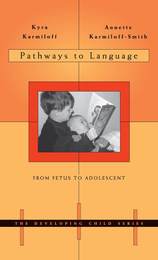 Pathways to Language: From Fetus to Adolescent
Kyra Karmiloff and Annette Karmiloff-Smith
Harvard University Press, 2002 Our journey to language begins before birth, as babies in the womb hear clearly enough to distinguish their mother's voice. Canvassing a broad span of experimental and theoretical approaches, this book introduces new ways of looking at language development.
A remarkable mother-daughter collaboration, Pathways to Language balances the respected views of a well-known scholar with the fresh perspective of a younger colleague prepared to challenge current popular positions in these debates. The result is an unusually subtle, even-handed, and comprehensive overview of the theory and practice of language acquisition, from fetal speech processing to the development of child grammar to the sophisticated linguistic accomplishments of adolescence, such as engaging in conversation and telling a story.
With examples from the real world as well as from the psychology laboratory, Kyra Karmiloff and Annette Karmiloff-Smith look in detail at the way language users appropriate words and grammar. They present in-depth evaluations of different theories of language acquisition. They show how adolescent usage has changed the meaning of certain phrases, and how modern living has led to alterations in the lexicon. They also consider the phenomenon of atypical language development, as well as theoretical issues of nativism and empiricism and the specificity of human language. Their nuanced and open-minded approach allows readers to survey the complexity and breadth of the fascinating pathways to language acquisition.
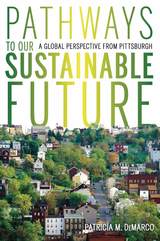 Pathways to Our Sustainable Future: A Global Perspective from Pittsburgh
Patricia M. DeMarco
University of Pittsburgh Press, 2017 Winner, 2019 Carnegie Science Award
Pittsburgh has a rich history of social consciousness in calls for justice and equity. Today, the movement for more sustainable practices is rising in Pittsburgh. Against a backdrop of Marcellus shale gas development, initiatives emerge for a sustainable and resilient response to the climate change and pollution challenges of the twenty-first century. People, institutions, communities and corporations in Pittsburgh are leading the way to a more sustainable future.
Examining the experience of a single city, with all of its social and political complexities and long industrial history, allows a deeper understanding of the challenges and opportunities inherent in adapting to a changing world. Choices for more sustainable pathways for the future include transforming the energy system, restoring infertile ground, and preventing pollution through green chemistry production. Throughout the book, case studies responding to ethical challenges give specific examples of successful ways forward. Inspired by Rachel Carson’s voice of precaution in protecting the Earth, this is a book about empowerment and hope.
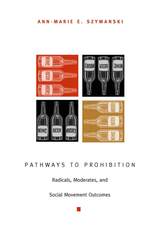 Pathways to Prohibition: Radicals, Moderates, and Social Movement Outcomes
Ann-Marie E. Szymanski
Duke University Press, 2003 Strategies for gradually effecting social change are often dismissed as too accommodating of the status quo. Ann-Marie E. Szymanski challenges this assumption, arguing that moderation is sometimes the most effective way to achieve change. Pathways to Prohibition examines the strategic choices of social movements by focusing on the fates of two temperance campaigns. The prohibitionists of the 1880s gained limited success, while their Progressive Era counterparts achieved a remarkable—albeit temporary—accomplishment in American politics: amending the United States Constitution. Szymanski accounts for these divergent outcomes by asserting that choice of strategy (how a social movement defines and pursues its goals) is a significant element in the success or failure of social movements, underappreciated until now. Her emphasis on strategy represents a sharp departure from approaches that prioritize political opportunity as the most consequential factor in campaigns for social change. Combining historical research with the insights of social movement theory, Pathways to Prohibition shows how a locally based, moderate strategy allowed the early-twentieth-century prohibition crusade both to develop a potent grassroots component and to transcend the limited scope of local politics. Szymanski describes how the prohibition movement’s strategic shift toward moderate goals after 1900 reflected the devolution of state legislatures’ liquor licensing power to localities, the judiciary’s growing acceptance of these local licensing regimes, and a collective belief that local electorates, rather than state legislatures, were best situated to resolve controversial issues like the liquor question. "Local gradualism" is well suited to the porous, federal structure of the American state, Szymanski contends, and it has been effectively used by a number of social movements, including the civil rights movement and the Christian right.
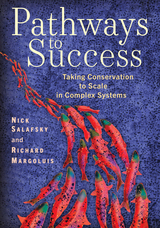 Pathways to Success: Taking Conservation to Scale in Complex Systems
Nick Salafsky and Richard Margoluis
Island Press, 2021 As environmental problems grow larger and more pressing, conservationists have had to adapt. With a shrinking window of time to act, they are turning to broad approaches to combat continental- and global-scale crises of biodiversity loss, invasive species, and climate change. Pathways to Success—the long-awaited successor to the classic volume Measures of Success—is a modern guide to building large-scale transformative programs capable of tackling the complex conservation crises we face today.
In this strikingly illustrated volume, coauthors Nick Salafsky and Richard Margoluis walk readers through fundamental concepts of effective program-level design, helping them to think strategically about project coordination, funding, and stakeholder input. Chapters in the first part of the book look at all aspects of designing and implementing large-scale conservation programs while the second part focuses on how to use data and information to manage, adapt, and learn from program strategies. In addition, the authors offer practical advice for avoiding pitfalls, such as formulaic recipes and simplistic silver-bullet solutions that can trip up otherwise well-intentioned efforts. Abundant graphics help to explain and clarify concepts presented in the text, and a glossary in the back matter defines technical terms for the reader.
Pathways to Success is the definitive guide for conservation program managers and funders who want to increase the scale and effectiveness of their work combating biodiversity loss, climate change, and other pressing environmental issues.
 Pathways to Sustainability: Collaborative Solutions for a Resilient Future
Edited by Timothy L. Killeen, Donald J. Wuebbles, and Jason E. Lane
University of Illinois Press, 2025 In an era defined by unprecedented environmental challenges and rapid societal change, how can we build a sustainable and resilient future? In this collection, the editors bring together groundbreaking insights and inspiring stories from around the globe, illuminating how innovative partnerships across sectors and borders are driving meaningful progress toward sustainability. Contributors from science, business, non-governmental organizations, and university leadership engage across their areas of expertise to discuss how to apply cutting-edge research toward understanding, mitigating, and adapting to today’s alarming environmental stresses. Throughout, the essayists showcase breakthroughs in sustainability science while providing a blueprint for creating collaborations, expanding networks, and connecting with new markets. Essential reading for sustainability leaders, educators, policymakers, and change-makers everywhere, this volume offers a visionary yet practical roadmap for harnessing the power of collaboration to advance practical solutions necessary to ensure a thriving planet for future generations. Expert and interdisciplinary, Pathways to Sustainability focuses on human capacity building and innovation to explore holistic solutions to climate change, unsustainable resource consumption, and other inevitable challenges of our time. Contributors: Nicole Arbour, Rebecca T. Barnes, Kyle Blount, Kayla Boparai, Caleb S. Brooks, Benjamin B. Campion, Christopher Castle, William L. Chadderton, Kenneth T. Christensen, Emily M. Clegg, Asher Cohen, Jonathan Coppess, Nathan L. Cummins, John D. Den Uyl, Miranda N. Domico, Francina Dominguez, Patrick J. Doran, Kelvin K. Droegemeier, Pengyue Du, Luis Gomez Echeverri, Brian Fath, John Ferry, Trent W. Ford, Regina Mae Francia, Georgie B. Geraghty, Janet Gooch, Timothy P. Grunloh, Kaiyu Guan, Luiz Gutierrez, Sam S. Haapaniemi, Julian Heiss, Barb Helland, Catherine Hurley, Atul K. Jain, Paul Kearns, Timothy L. Killeen, Rao Kotamarthi, Jason E. Lane, Wendy Larner, John T. Legge, L. Ruby Leung, Peiyuan Li, Leila Loupis, Josephine M. Malonza, Mark Manns, Lia Merminga, Maria J. Molina, David Muchangi Mugo, Meridith F. Muth, Selvaprabu Nadarajah, Cristina Negri, Pratik Patil, Andreas F. Prein, Ziqi Qin, Fany Ramos Quispe, Jonathan Radcliffe, Omer Rana, Dan Reed, Alyssa Rodway, Christine Rovelli, Elena Rovenskaya, Gabriella Pinheiro Servi, Gavin Shaddick, John Shalf, Ashish Sharma, Bjorn Stevens, Tih-Fen Ting, Dennis Todey, John Towns, Andrew J. Tucker, Albert van Jaarsveld, Carolina Veiga, Abhinav Wadhwa, Peter W. Wangai, Melissa Widhalm, Aaron B. Wilson, Molly Woloszyn, Sicheng Wu, Donald J. Wuebbles, and Joel Zavala
Pathways to the Old Northwest: An Observance of the Bicentennial of the Northwest Ordinance
Lloyd A. Hunter, et al
Indiana Historical Society Press, 1988 In 1987 Franklin College of Indiana hosted an observance of the bicentennial of the Northwest Ordinance. Professional and amateur historians, folklorists, scholars in the arts, teachers, and students gathered to examine the provisions of that historic document and the governmental structure it created for the frontier lands north of the Ohio River. Pathways to the Old Northwest: An Observance of the Bicentennial of the Northwest Ordinance presents six of the lectures delivered at the conference. These lectures represent current knowledge about the early history of the Ohio River-Great Lakes area, the circumstances surrounding passage of the Ordinance, the beginnings of government and society, and the ethnic diversity of the region's people.
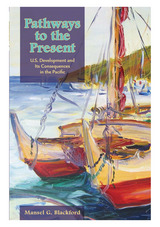 Pathways to the Present: U.S. Development and its Consequences in the Pacific
Mansel G. Blackford
University of Hawaii Press, 2007 Ranging from the Hawaiian Archipelago to the Aleutian Islands, from Silicon Valley to Guam, Pathways to the Present is a thoroughly researched and concisely argued account of economic and environmental change in the postwar "American" Pacific. Following a brief survey of the history of the Pacific, the author takes the Hawaiian Islands as the center of American activities in the region and looks at interactions among native Hawaiian, developmental, military, and environmental issues in the archipelago after World War II.
He then turns to land- and water-use problems that have intersected with more nebulous quality-of-life concerns to generate policy controversies in the Seattle region and the San Francisco Bay area, especially Silicon Valley. Economic expansion and environmentalism in Alaska are examined through the lens of changes occurring along the Aleutians. From there the study considers Hiroshima after its destruction by the atomic bomb in 1945, looking at residents’ desire to combine urban-planning concepts. The author investigates the effort to remake Hiroshima as a high-tech city in the 1990s, an attempt inspired by the perceived success of Silicon Valley, and postwar planning on Okinawa, where American influences were particularly strong. The final chapter takes into account issues raised on Guam regarding the growth of tourism and the use of the island for military purposes and links these to developments in the Philippines to the west and American Sâmoa to the south.
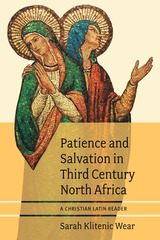 Patience and Salvation in Third Century North Africa: A Christian Latin Reader
Sarah Wear
Catholic University of America Press, 2022 Patience and Salvation in Third Century North Africa: A Christian Latin Reader features the entirety of Tertullian’s To Martyrs and The Passion of Perpetua and Felicity, with selections from Cyprian’s On the Good of Patience and a short appendix on Augustine’s Commentary on Psalm 121.6. The Latin text has facing vocabulary and theological, historical, philosophical, and grammatical notes.
In the first three centuries, Roman Carthage produced some of the earliest literature composed originally in Latin by Christians. Tertullian’s Ad Martyras (197); Passio Perpetuae et Felicitatis (203), and Cyprian’s De Bono Patientiae (256) all embody the force of this new genre of Latin literature. With this literature, we see a variant of Latin often denoted “Christian Latin.” Christian Latin featured linguistic elements marked by characteristics of biblical Latin, later Latin, as well as vulgarisms.
In addition to converging philologically, Tertullian, the author of the Passio, and Cyprian align themselves in topos: they all ask the question of how one can endure torment and anxiety in this world. Patience (patientia), derived from the verb for “to suffer” (patior), is a virtue that allows one to endure troubles, anxieties, and physical pains with the hope of eternal happiness and salvation in heaven. In this Reader, the student will find three different literary perspectives on this theme. The book also draws parallels to the works of Seneca and Cicero on patience and suffering.
The Patience of Ice
Renate Wood
Northwestern University Press, 2000 Filled with awe at the improbable, incomprehensible trajectory of human experience, Renate Wood ponders history, memory, and family. Beginning with the sequence titled "German Chronicle," Wood evokes her childhood in Germany during the WWII, recording the war's impact on the world in general and on her family in particular. Her poems move between the past and the present, from family life to mythology, and are distinguished by intellectual and emotional courage, metaphoric surprise, and linguistic clarity.
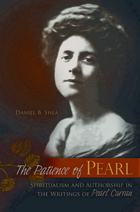 The Patience of Pearl: Spiritualism and Authorship in the Writings of Pearl Curran
Daniel B. Shea
University of Missouri Press, 2012 When St. Louis homemaker Pearl Curran began writing fiction and poetry at a Ouija board in 1913, she attributed the work to the “discarnate entity” Patience Worth, a seventeenth-century Puritan. Though now virtually forgotten, her writing garnered both critical praise and public popularity at the time. The Patience of Pearl uncovers more of Curran’s (and thus Patience Worth’s) biography than has been known before; Daniel B. Shea provides close readings of the Patience-dictated writings and explores the historical and local context, applying current cognitive and neuro-psychology research. Though Pearl Curran had only a ninth-grade education, Patience Worth was able to dictate a biblical novel and a Victorian novel. Echoes of Dickens and the Potters, a circle of St. Louis women writers, make clear that Patience Worth reflects literary debts that go as far back as Curran being read to as a child. Shea argues that the workings of implicit memory suggest the medium’s creative achievements were her own body’s property. Curran also had musical training, and recent developments in the field of psychology regarding the overlap between musical and linguistic rhythms of regularity, anticipation, and surprise supply a firm foundation for attributing skills both automatic and creative to Curran. Her reflections on her doubleness in her self-study anticipate the many-personed Ouija board writing of poet James Merrill. Shea approaches Curran/Worth as a summary figure for the Victorian-era woman writer’s buried voice at the point of its transition into modernism. He investigates many lingering questions about Curran’s fluent productivity at the Ouija board, including the “smart” versus “dumb” unconscious. Shea links unconscious memory, dissociation, and automatic writing and reconsiders problematic assumptions about individual identity and claims of personal agency. The Curran/Worth Puritan/writer figure also allows scrutiny of gendered assumptions about the dangers of female speech and the idealization of women’s passive reception of divine, or husbandly, revelation. Novelistic in its own way, Curran’s life included three husbands and a child adopted on command from Patience Worth. Pearl Curran enjoyed a brief period of celebrity in Los Angeles before her death in 1937. The Patience of Pearl once again brings her the attention she deserves—for her life, her writing, and her place in women’s literary history.
 Patient Citizens, Immigrant Mothers: Mexican Women, Public Prenatal Care, and the Birth Weight Paradox
Galvez, Alyshia
Rutgers University Press, 2011 According to the Latina health paradox, Mexican immigrant women have less complicated pregnancies and more favorable birth outcomes than many other groups, in spite of socioeconomic disadvantage. Alyshia Gálvez provides an ethnographic examination of this paradox. What are the ways that Mexican immigrant women care for themselves during their pregnancies? How do they decide to leave behind some of the practices they bring with them on their pathways of migration in favor of biomedical approaches to pregnancy and childbirth? This book takes us from inside the halls of a busy metropolitan hospital’s public prenatal clinic to the Oaxaca and Puebla states in Mexico to look at the ways Mexican women manage their pregnancies. The mystery of the paradox lies perhaps not in the recipes Mexican-born women have for good perinatal health, but in the prenatal encounter in the United States. Patient Citizens, Immigrant Mothers is a migration story and a look at the ways that immigrants are received by our medical institutions and by our society
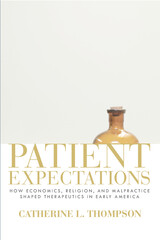 Patient Expectations: How Economics, Religion, and Malpractice Shaped Therapeutics in Early America
Catherine L. Thompson
University of Massachusetts Press, 2015 During the first half of the nineteenth century a major shift occurred in the medical treatment of illness in the United States, as physicians abandoned the use of "heroic" depletive therapies—the pukes and purges made famous in the 1790s by Dr. Benjamin Rush of Philadelphia—in favor of a let-nature-take-its-course approach to most diseases. Standard histories of American medicine have long attributed this shift to new theories and training methods as well as increased competition from homeopaths and botanical doctors. In this book, Catherine L. Thompson challenges that interpretation by emphasizing the role of patients as active participants in their own health care rather than passive objects of medical treatment.
Focusing on Massachusetts, then as now a center of U.S. medical education and practice, Thompson draws on data from patients' journals, medical account ledgers, physicians' daybooks, and court records to link changes in medical treatment to a gradual evolution of patient expectations across varied populations. Specifically, she identifies three developments—the increasing use of cash in medical transactions, growing religious pluralism, and the rise of malpractice suits—as key factors in transforming patients into active medical consumers unwilling to submit to doctors' advice without considering alternatives.
By showing how nineteenth-century patients shaped therapeutic practice "through the medical choices they made or didn't make," Thompson's study alters our understanding of American medicine in the past and has implications for its present and future.
 The Patient Is an Unreliable Historian
Brody Parrish Craig
Omnidawn, 2024 A poetry collection that questions the current construction of psychiatric treatment while speaking through lived experience and advocating for disability justice.
The poems of Brody Parrish Craig’s new collection upends narratives around current psychiatric treatment models to focus on the lived experience of survivors and to speak toward liberation, abolition, and disability justice. Titled after the author’s own medical records, The Patient Is an Unreliable Historian questions the prevailing narrative that the medical industry knows stories of disability and madness better than those who have lived them.
Craig uses lyricism to expose the intersection of madness and criminality in contemporary American culture, moving through institutions, community spaces, and loss of kin. Through the course of the collection, the speaker turns toward irreverence and interrogation, carves out their own freedom, and challenges the script of the patient, the mad, and the “criminal.” These poems deconstruct the “patient” to set the person free.
 Patient Listening: A Doctor's Guide
Loreen Herwaldt
University of Iowa Press, 2008 From the fictional portrayal of Dr. Gregory House to Jerome Groopman's bestseller How Doctors Think, both medical professionals and the general public recognize that there is more to the doctor's job than technical practice. Yet why do so many patients come away from their doctors' offices feeling dissatisfied with their interactions? In this welcome addition to the growing field of narrative medicine, physician Loreen Herwaldt uses the illness narratives of two dozen writer-patients to teach listening skills to medical students, residents, physicians, and other health care providers.
Herwaldt skillfully pares each narrative down to its most basic elements, rendering them into powerful found poems that she has used successfully in her role as a teacher and in her own practice. Drawing from narratives by writers who are both emerging and well known, including Oliver Sacks, Richard Selzer, and Mary Swander, each poem reveals the experience of illness and treatment from the patient's perspective. Patient Listening includes a detailed general introduction and a how-to guide that will prove invaluable in the classroom and in clinical practice.
This book will inspire thoughtfulness in everyone who reads it. It is also designed to foster discussions about all aspects of the patient experience from ethics to stigmatization to health insurance. Patient Listening is not just about bedside manner but also about how health care providers can gain the most from their interactions with patients and in turn offer more appropriate treatments, develop more cooperative and responsive relationships with their patients, and thus become better doctors.
 The Patient Self-Determination Act: Meeting the Challenges in Patient Care
Lawrence P. Ulrich
Georgetown University Press The Patient Self-Determination Act of 1990 required medical facilities to provide patients with written notification of their right to refuse or consent to medical treatment. Using this Act as an important vehicle for improving the health care decisionmaking process, Lawrence P. Ulrich explains the social, legal, and ethical background to the Act by focusing on well-known cases such as those of Karen Quinlan and Nancy Cruzan, and he explores ways in which physicians and other caregivers can help patients face the complex issues in contemporary health care practices. According to Ulrich, health care facilities often address the letter of the law in a merely perfunctory way, even though the Act integrates all the major ethical issues in health care today. Ulrich argues that well-designed conversations between clinicians and patients or their surrogates will not only assist in preserving patient dignity — which is at the heart of the Act—but will also help institutions to manage the liability issues that the Act may have introduced. He particularly emphasizes developing effective advance directives. Ulrich examines related issues, such as the negative effect of managed care on patient self-determination, and concludes with a seldom-discussed issue: the importance of being a responsible patient. Showing how the Patient Self-Determination Act can be a linchpin of more meaningful and effective communication between patient and caregiver, this book provides concrete guidance to health care professionals, medical ethicists, and patient-rights advocates.
 Patient Sense: Rhetorical Body Work in the Age of Technology
Lillian Campbell
Ohio State University Press, 2025 Technological innovations are rapidly changing the healthcare landscape. When nurses can complete portions of their clinical hours in virtual simulations and medical assistants might spend their entire careers providing patient care mediated by a screen, their understandings of their professional roles change. For future providers, rhetoric is at the heart of learning to communicate with patients and reframing their understandings of expertise. In Patient Sense, Lillian Campbell introduces a theory of rhetorical body work and applies it to three distinct healthcare contexts: clinical nursing simulations, physical therapy labs, and tele-observation in a virtual intensive care unit. Drawing on sociological frameworks, she defines rhetorical body work as paid physical, emotional, or discursive labor performed at the material or technological interface of worker–client bodies. Such work is devalued within social and institutional systems and often gendered and racialized. Campbell captures the value of providers’ intuitive patient sense in the face of increasingly technology-mediated healthcare and intervenes in conversations about the future of healthcare training. Ultimately, she demonstrates that we will always need responsive healthcare providers whose rhetorical body work and patient sense cannot be replaced by technicians or algorithms.
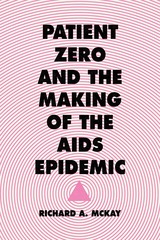 Patient Zero and the Making of the AIDS Epidemic
Richard A. McKay
University of Chicago Press, 2017 Now an award-winning documentary feature film
The search for a “patient zero”—popularly understood to be the first person infected in an epidemic—has been key to media coverage of major infectious disease outbreaks for more than three decades. Yet the term itself did not exist before the emergence of the HIV/AIDS epidemic in the 1980s. How did this idea so swiftly come to exert such a strong grip on the scientific, media, and popular consciousness? In Patient Zero, Richard A. McKay interprets a wealth of archival sources and interviews to demonstrate how this seemingly new concept drew upon centuries-old ideas—and fears—about contagion and social disorder.
McKay presents a carefully documented and sensitively written account of the life of Gaétan Dugas, a gay man whose skin cancer diagnosis in 1980 took on very different meanings as the HIV/AIDS epidemic developed—and who received widespread posthumous infamy when he was incorrectly identified as patient zero of the North American outbreak. McKay shows how investigators from the US Centers for Disease Control inadvertently created the term amid their early research into the emerging health crisis; how an ambitious journalist dramatically amplified the idea in his determination to reframe national debates about AIDS; and how many individuals grappled with the notion of patient zero—adopting, challenging and redirecting its powerful meanings—as they tried to make sense of and respond to the first fifteen years of an unfolding epidemic. With important insights for our interconnected age, Patient Zero untangles the complex process by which individuals and groups create meaning and allocate blame when faced with new disease threats. What McKay gives us here is myth-smashing revisionist history at its best.
Patient-Centered Digital Healthcare Technology: Novel applications for next generation healthcare systems
Leonard Goldschmidt
The Institution of Engineering and Technology, 2021 Patient-Centered Digital Healthcare Technology explores the creative intersection of novel, emerging technologies and medicine. This convergence is transforming the landscape of healthcare with the overarching objectives of improving clinical outcomes and advocating wellness. The concept of encountering or treating a medical condition when it has already become disturbingly manifest is being replaced by earlier awareness, diagnosis, and proactive intervention enabled by technologies.
Patients as Policy Actors
Hoffman, Beatrix
Rutgers University Press, 2011 Patients as Policy Actors offers groundbreaking accounts of one of the health field's most important developments of the last fifty years--the rise of more consciously patient-centered care and policymaking. The authors in this volume illustrate, from multiple disciplinary perspectives, the unexpected ways that patients can matter as both agents and objects of health care policy yet nonetheless too often remain silent, silenced, misrepresented, or ignored. The volume concludes with a unique epilogue outlining principles for more effectively integrating patient perspectives into a pluralistic conception of policy-making. With the recent enactment of the Patient Protection and Affordable Care Act, patients' and consumers' roles in American health care require more than ever the careful analysis and attention exemplified by this innovative volume.
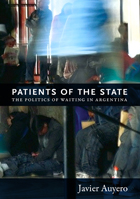 Patients of the State: The Politics of Waiting in Argentina
Javier Auyero
Duke University Press, 2012 Patients of the State is a sociological account of the extended waiting that poor people seeking state social and administrative services must endure. It is based on ethnographic research in the waiting area of the main welfare office in Buenos Aires, in the line leading into the Argentine registration office where legal aliens apply for identification cards, and among people who live in a polluted shantytown on the capital’s outskirts, while waiting to be allocated better housing. Scrutinizing the mundane interactions between the poor and the state, as well as underprivileged people’s confusion and uncertainty about the administrative processes that affect them, Javier Auyero argues that while waiting, the poor learn the opposite of citizenship. They learn to be patients of the state. They absorb the message that they should be patient and keep waiting, because there is nothing else that they can do. Drawing attention to a significant everyday dynamic that has received little scholarly attention until now, Auyero considers not only how the poor experience these lengthy waits but also how making poor people wait works as a strategy of state control.
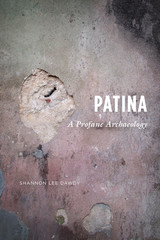 Patina: A Profane Archaeology
Shannon Lee Dawdy
University of Chicago Press, 2016 When Hurricane Katrina struck New Orleans, the world reacted with shock on seeing residents of this distinctive city left abandoned to the floodwaters. After the last rescue was completed, a new worry arose—that New Orleans’s unique historic fabric sat in ruins, and we had lost one of the most charming old cities of the New World.
In Patina, anthropologist Shannon Lee Dawdy examines what was lost and found through the destruction of Hurricane Katrina. Tracking the rich history and unique physicality of New Orleans, she explains how it came to adopt the nickname “the antique city.” With innovative applications of thing theory, Patina studies the influence of specific items—such as souvenirs, heirlooms, and Hurricane Katrina ruins—to explore how the city’s residents use material objects to comprehend time, history, and their connection to one another. A leading figure in archaeology of the contemporary, Dawdy draws on material evidence, archival and literary texts, and dozens of post-Katrina interviews to explore how the patina aesthetic informs a trenchant political critique. An intriguing study of the power of everyday objects, Patina demonstrates how sharing in the care of a historic landscape can unite a city’s population—despite extreme divisions of class and race—and inspire civil camaraderie based on a nostalgia that offers not a return to the past but an alternative future.
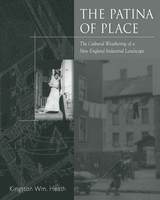 The Patina Of Place: The Cultural Weathering Of A New England Industrial
Kingston Wm Heath
University of Tennessee Press, 2001 In the late nineteenth and early twentieth centuries, the booming textile industry turned many New England towns and villages into industrialized urban centers. This rapid urbanization transformed the built environment of communities such as New Bedford, Massachusetts, as new housing styles emerged to accommodate the largely immigrant workforce of the mills. In particular, the wood-frame “three-decker” became the region’s multifamily housing design of choice in urban areas and is widely acknowledged as a unique architectural form that is characteristic of New England. In The Patina of Place, Kingston Heath offers the first book-length analysis of the three-decker and its cultural significance, revealing New Bedford’s evolving regional identity within New England.
The Patina of Place offers a multidisciplinary analysis of workers’ housing as an index to social change and cultural identity in New Bedford from 1848 to 1925. Heath discusses both the city’s company-owned mill housing and the subsequent transition to a speculative building market that established the three-decker rental flat as the city’s most common housing form for industrial workers.
Using the concept of “cultural weathering” to explore the cultural imprints left by inhabitants on their built environment, Heath considers whether the three-decker is a generic “type” that could be transferred elsewhere. He concludes that the ethnic, economic, and geographic conditions of a locale serve as filters that reshape the meaning, utility, and character of a building form, thereby making it an integral part of its particular community. Specifically, he shows how the three-decker was lived in, and used by, its original inhabitants and illustrates its transformation by later generations of residents following the collapse of the textile industry in the mid-1920s.
The Patina of Place focuses on the three-decker in New Bedford, but its overarching theme concerns the cultural, economic, and social complexities of place-making and the creation of regional identity. Heath offers a broad investigation of the forces that drive the production and consumption of architecture, at the same time providing an economic and cultural context for the emergence of a particular architectural form.
The Author: Kingston Heath is associate professor in the college of architecture at the University of North Carolina at Charlotte. His articles have appeared in The Encyclopedia of Architecture and Old-Time New England, among other publications.
Patmos
Bruce Bond
University of Massachusetts Press, 2021 The dead are never far from the living in Patmos, the end is always nigh, and the cultural symptoms of denial and reconciliation, unresolved shame and loneliness, remain just beneath the surface: "It is how, these many / years, we survived. In our rooms, alone, at the end of time." In this book-length poetic sequence, Bruce Bond explores the psychology of endings as a living presence that haunts our spiritual, moral, and ecological imaginations, elevates its summons, and draws us to question its significance. The horrors and glories in the revelations of John of Patmos provide a lens into a wound, a crisis of values, a longing to heal a visionary brokenness that is fundamentally solitary and yet contemporary, written against a door that will not open.
 Patriarch and Folk: The Emergence of Nicaragua, 1798-1858
E. Bradford Burns
Harvard University Press, 1991 The painful sixty-year process that brought Nicaragua from colonial status to incipient nation-state is the focus of this fresh examination of inner struggle in a key isthmian country. E. Bradford Burns shows how Nicaragua's elite was able to consolidate control of the state and form a stable government, resolving the bitter rivalry between the two cities Le&oacu;n and Granada, but at the same time began the destruction of the rich folk culture of the Indians, eventually reducing them to an impoverished and powerless agrarian proletariat.
The history of this nation echoes that of other Latin American lands yet is peculiarly its own. Nicaragua emerged not from a war against Spain but rather from the violent interactions among the patriarchs of the dominant families, the communities of common people, and foreigners. Burns is eloquent on the subject of American adventurism in Nicaragua, which culminated in the outrageous expedition of the filibuster William Walker and his band of mercenaries in the 1850s. It was a major breach of the trust and friendship Nicaraguans had extended to the United States, and the Nicaraguans' subsequent victory over the foreign invaders helped forge their long-delayed sense of national unity.
The decimation of Nicaraguan archives for the period prior to 1858 renders the study of early nineteenth-century history especially challenging, but Burns has made ingenious use of secondary sources and the few published primary materials available, including travelers' accounts and other memoirs, newspapers, government reports, and diplomatic correspondence. He provides valuable insight into Nicaraguan society of the time, of both the elite and the folk, including a perceptive section on the status and activities of women and the family in society. This book will appeal not only to professional historians but to general readers as well.
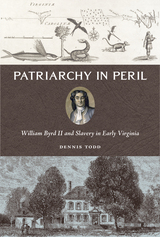 Patriarchy in Peril: William Byrd II and Slavery in Early Virginia
Dennis Todd
University of Tennessee Press, 2023 William Byrd II was a prominent eighteenth-century Virginian who at the time of his death owned over 180,000 acres and employed laborers and enslaved Africans to work his land. His letters, diaries, and surveying documents have become key texts in the study of American history, and he is one of the most quoted and discussed figures of his era.
Byrd himself was perhaps the early colonial epitome of a patriarch, and typically, when historians examine Byrd and the prominence of patriarchal thought in colonial Virginia, they examine his relationships with his immediate family. In this book, however, Dennis Todd examines the patriarchal relations between Byrd and the workers on his plantations—his apprentices, his wageworkers, his overseers, his white servants, and especially his slaves. In doing so, this book illuminates a neglected stage in the formation of slavery in Virginia. Todd argues that patriarchal principles, which are often assumed to have justified slavery and to have offered a template for slave management, in fact did neither. Byrd was not the only Virginian to wrestle with the contradictions between patriarchal values and the realities of slavery, but few were as articulate.
In examining Byrd through the twin lens of slavery and patriarchy, Patriarchy in Peril makes an important contribution to our understanding of the man and his place in Virginia society as well as the contentious formation of early America.
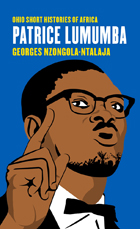 Patrice Lumumba
Georges Nzongola-Ntalaja
Ohio University Press, 2014 Patrice Lumumba was a leader of the independence struggle in what is today the Democratic Republic of the Congo, as well as the country’s first democratically elected prime minister. After a meteoric rise in the colonial civil service and the African political elite, he became a major figure in the decolonization movement of the 1950s. Lumumba’s short tenure as prime minister (1960–1961) was marked by an uncompromising defense of Congolese national interests against pressure from international mining companies and the Western governments that orchestrated his eventual demise. Cold war geopolitical maneuvering and well-coordinated efforts by Lumumba’s domestic adversaries culminated in his assassination at the age of thirty-five, with the support or at least the tacit complicity of the U.S. and Belgian governments, the CIA, and the UN Secretariat. Even decades after Lumumba’s death, his personal integrity and unyielding dedication to the ideals of self-determination, self-reliance, and pan-African solidarity assure him a prominent place among the heroes of the twentieth-century African independence movement and the worldwide African diaspora. Georges Nzongola-Ntalaja’s short and concise book provides a contemporary analysis of Lumumba’s life and work, examining both his strengths and his weaknesses as a political leader. It also surveys the national, continental, and international contexts of Lumumba’s political ascent and his swift elimination by the interests threatened by his ideas and practical reforms.
 Patricia Johanson’s House and Garden Commission: Re-construction of Modernity
Xin Wu
Harvard University Press, 2007 In 1969, House and Garden magazine commissioned one of the first minimalist artists, Patricia Johanson, to propose new directions for American garden art. Having never been exhibited or published before as a whole, the resulting garden proposals reveal an unknown dimension of the New York art world of the late 1960s. Three years of research have brought 146 surviving drawings to light. They demonstrate the intimate progress of the artist’s engagement with nature in her quest for an art concerned with ethical relationships between humans and the natural world. Shuttling between the West and the East, and the contemporary and the historical, Johanson takes equal distances from earthworks created by her peer artists such as Robert Smithson, and the environmentalism advocated by landscape architects following Ian McHarg. Her vision of a new modernity is still significant today. The book is divided into 2 volumes, and includes a preface by Stephen Bann and a catalogue of 146 original garden proposals.
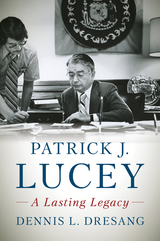 Patrick J. Lucey: A Lasting Legacy
Dennis L. Dresang
Wisconsin Historical Society Press, 2020 As Wisconsin governor from 1971 to 1977, Patrick J. Lucey pursued an ambitious progressive agenda, tempered by the concerns of a fiscal conservative and a pragmatic realist. He was known for bridging partisan divides, building coalitions, and keeping politics civil. His legacy, which included merging Wisconsin’s universities into one system and equalizing the funding formula for public schools, continues to impact Wisconsin residents and communities.
Preceding his service as governor, Lucey played a key role in rebuilding the Democratic Party in Wisconsin, returning a state that had been dominated by Republicans to a more moderate two-party system. As party chairman, he built coalitions between World War II veterans, remnants of the defunct Progressive Party, urban socialists, and activists in rural communities throughout the state.
Through exclusive interviews and unprecedented access to archival materials, Dennis L. Dresang shares the story of this pivotal figure in Wisconsin history, from his small-town rural roots to his wide-ranging influence.
 Patrick Leigh Fermor: Noble Encounters between Budapest and Transylvania
Michael O'Sullivan
Central European University Press, 2018 This book revisits the trajectory of one section of Patrick Leigh Fermor's famous excursion on foot from the Hook of Holland to Constantinople in the 1930s. The highly regarded British travel writer and heroic wartime Special Operations Executive officer walked into Hungary as a youth of 19 at Easter and left Transylvania in August 1934. This intrepid traveler, "a cross between Indiana Jones, James Bond and Graham Greene" as the New York Times obituary put it in 2011, published his experiences half a century later. Between the Woods and the Water, that covers the part of the epic foot journey from the middle Danube to the Iron Gates, has been a bestseller since it was first published in 1986. In the present volume Michael O'Sullivan reveals the identity of the interesting characters in the travelogue, interviewing several of them eyetoeye. The many counts and barons among his 1934 contacts are a proof of Leigh Fermor's lifelong attraction to the aristocracy. Rich with photos and other documents on places and persons both from the thirties and today, the book offers a compelling social and political history of the period and the area. It provides a particular portrait of Hungary and Transylvania when they were on the brink of momentous change.
 Patrick White Letters
Patrick White
University of Chicago Press, 1996 "Letters are the devil, and I always hope that any I have written have been destroyed."—Patrick White
Patrick White spent his whole life writing letters. He wanted them all burnt, but thousands survive to reveal him as one of the greatest letter-writers of his time. Patrick White: Letters is an unexpected and final volume of prose by Australia's most acclaimed novelist. Only a few scraps of White's letters have been published before.
From the aftermath of the First World War until his death in 1990, letters poured from White's pen: they are shrewd, funny, dramatic, pigheaded, camp, and above all, hauntingly beautiful. He wrote novels to sway a hostile world, but letters were for friends.
The culmination of ten years' work and reflection by David Marr, author of the well-received biography Patrick White: A Life, the volume tells the story of White's life in his own words. These are the letters of a great writer, a profound critic, a gossip with the sharpest eyes and tongue, a man who loved and hated ferociously, a keen cook, an angry patriot, and a believer never free of doubt.
"A literary milestone."—Kirkus Reviews
"Mean-spirited and brilliant, the 600 letters collected here offer real insight into the life of the Nobel-Prize winning Australian author. White's venom is matched by his torment, and the whole volume is redeemed by outstanding writing."—Publisher's Weekly ("Best Books 96")
"[T]hose who come to these letters after having read Marr's biography will expect more than shop talk from the master novelist. They will expect the bracing bitchiness of a master curmudgeon. And they will not be disappointed."—Frank Wilson, Philadelphia Inquirer
Patrick White (1912-1990), Australian novelist and playwright, won the Nobel Prize in Literature in 1973. His many novels include Voss, The Twyborn Affair, and Riders in the Chariot.
The Patriotic Consensus: Unity, Morale, and the Second World War in Winnipeg
Jody Perrun
University of Manitoba Press, 2014 When the Second World War broke out, Winnipeg was Canada’s fourth-largest city, home to strong class and ethnic divisions, and marked by a vibrant tradition of political protest. Citizens demonstrated their support for the war effort through their wide commitment to initiatives such as Victory Loan campaigns or calls for voluntary community service. But given Winnipeg’s diversity, was the Second World War a unifying event for Winnipeg residents? In The Patriotic Consensus, Jody Perrun explores the wartime experience of ordinary Winnipeggers through their responses to recruiting, the treatment of minorities, and the adjustments made necessary by family separation.
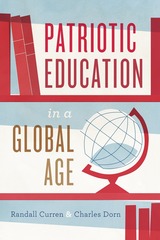 Patriotic Education in a Global Age
Randall Curren and Charles Dorn
University of Chicago Press, 2018 Should schools attempt to cultivate patriotism? If so, why? And what conception of patriotism should drive those efforts? Is patriotism essential to preserving national unity, sustaining vigorous commitment to just institutions, or motivating national service? Are the hazards of patriotism so great as to overshadow its potential benefits? Is there a genuinely virtuous form of patriotism that societies and schools should strive to cultivate?
In Patriotic Education in a Global Age, philosopher Randall Curren and historian Charles Dorn address these questions as they seek to understand what role patriotism might legitimately play in schools as an aspect of civic education. They trace the aims and rationales that have guided the inculcation of patriotism in American schools over the years, the methods by which schools have sought to cultivate patriotism, and the conceptions of patriotism at work in those aims, rationales, and methods. They then examine what those conceptions mean for justice, education, and human flourishing. Though the history of attempts to cultivate patriotism in schools offers both positive and cautionary lessons, Curren and Dorn ultimately argue that a civic education organized around three components of civic virtue—intelligence, friendship, and competence—and an inclusive and enabling school community can contribute to the development of a virtuous form of patriotism that is compatible with equal citizenship, reasoned dissent, global justice, and devotion to the health of democratic institutions and the natural environment. Patriotic Education in a Global Age mounts a spirited defense of democratic institutions as it situates an understanding of patriotism in the context of nationalist, populist, and authoritarian movements in the United States and Europe, and will be of interest to anyone concerned about polarization in public life and the future of democracy.
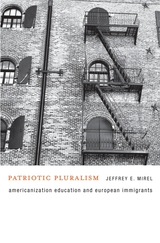 Patriotic Pluralism: Americanization Education and European Immigrants
Jeffrey E. Mirel
Harvard University Press, 2010 In this book, leading historian of education Jeffrey E. Mirel retells a story we think we know, in which public schools forced a draconian Americanization on the great waves of immigration of a century ago. Ranging from the 1890s through the World War II years, Mirel argues that Americanization was a far more nuanced and negotiated process from the start, much shaped by immigrants themselves.Drawing from detailed descriptions of Americanization programs for both schoolchildren and adults in three cities (Chicago, Cleveland, and Detroit) and from extensive analysis of foreign-language newspapers, Mirel shows how immigrants confronted different kinds of Americanization. When native-born citizens contemptuously tried to force them to forsake their home religions, languages, or histories, immigrants pushed back strongly. While they passionately embraced key aspects of Americanization—the English language, American history, democratic political ideas, and citizenship—they also found in American democracy a defense of their cultural differences. In seeing no conflict between their sense of themselves as Italians, or Germans, or Poles, and Americans, they helped to create a new and inclusive vision of this country.Mirel vividly retells the epic story of one of the great achievements of American education, which has profound implications for the Americanization of immigrants today.
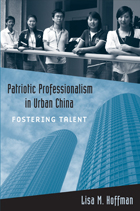 Patriotic Professionalism in Urban China: Fostering Talent
Authored by Lisa M. Hoffman
Temple University Press, 2010 In the post-Maoist era, China adopted a strategy for investing in the “quality” of its people—through education and training opportunities—that created talented labor. In her significant ethnographic study, Patriotic Professionalism in Urban China, Lisa Hoffman explains why the development of “human capital” is seen as fundamental for economic growth and national progress. She examines these new urban employees, who were deemed vital to the success of the global city in China, and who hoped for social mobility, a satisfying career, and perhaps a family. Patriotic Professionalism in Urban China addresses the emergence of this urban professional subject in Dalian, a port city in China. Hoffman identifies who these new professionals are, what choices they have made, and how they have remained closely connected with the nation—although not necessarily the Communist party—leading to a new social form she calls “Patriotic Professionalism.” Hoffman contributes to the understanding of changing urban life in China while providing an analysis of the country’s “late-socialist neoliberalism.” In the process, she asks pressing questions about how such shifts in urban life reshape cities, impact individual and family decisions, and reflect economic growth in China in tandem with “global” neoliberal practices.
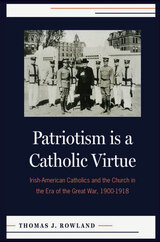 Patriotism is a Catholic Virtue: Irish-American Catholics, The American Church and the Coming of the Great War
Thomas J. Rowland
Catholic University of America Press, 2023 Most of the literature concerning the momentous challenges facing Irish American Catholics in the first two decades of the twentieth century pay but scant attention to the role played in addressing them by the American Church. Among the myriad political, social, cultural and economic issues confronting Irish American Catholics none stand out as prominently as the unabated burden of combatting scurrilous attacks upon them by nativist forces, the task of proving themselves as loyal American citizens, and navigating the perilous waves in advancing the course of directing Irish American nationalism and the cause of Ireland’s freedom.
Patriotism is a Catholic Virtue ferrets out the impact the institutional Church played in affecting the course of action Irish American Catholics took regarding these three crucial missions. Whereas the task of confronting the assaults of nativism, seemingly the natural task for the institutional Church, this study provides extensive evidence of the relentless defense of Catholic virtue conducted by diocesan newspapers. Similarly, the mission of promoting Catholics as loyal American citizens was largely left in the hands of the American hierarchy, its clergy, newspapers and Catholic societies and affiliates. Lastly, this book provides evidence that the Church may well have played the decisive role in guiding its Irish American faithful along paths that, while conservatively promoting Irish nationalism, did not jeopardize an “American First” policy for Catholics. All of this was accomplished in the crucible of an emerging worldwide war.
 Patriotism on Parade: The Story of Veterans' and Hereditary Organizations in America, 1783-1900
Wallace Evan Davies
Harvard University Press Since 1783, patriotic societies have become an integral part of American history. The great number of Sons, Daughters, and Dames, and the alphabetical jungle of G.A.R., D.A.R., V.F.W., U.C.V., U.D.C., W.R.D., etc. are well known--and are often subjects of controversy. Wallace Evan Davies here recounts, in fascinating detail, the activities and attitudes of both veterans' and hereditary patriotic societies in America up to 1900. In a lively manner, he explores their significance as social organizations, their concept of patriotism, and their influence upon public opinion and legislation.
At the close of the American Revolution a group of officers formed the first patriotic veterans' society, The Society of the Cincinnati--open to all officers who had served for three years or were in the army at the end of the Revolution. Thus it began. Then, after the Civil War, came the numerous organizations of veterans of both sides and of their relatives. And as some Americans became more nationalistic, others, becoming absorbed in family trees, started the many hereditary societies. After discussing the founding of men's, women's, and children's patriotic societies, the author describes their organizational aspects: their size, qualifications for membership, officers, dues, ritual, badges, costumes, and the like. In hereditary groups, membership wasdeliberately limited, for exclusiveness was often their strongest appeal. The veterans' groups, however, were usually anxious to be as large as possible so as to enhance their influence upon legislators.
The appearance, beginning in the 1860's, of nearly seventy patriotic newspapers and magazines testifies to the rising popularity of these groups: prominent publications of the patriotic press included The Great Republic, The Soldiers' Friend, The Grand Army Record, The Vedette, National Tribune, and American Tribune. Many people turned to patriotism as to a sort of secular religion in which their increasing differences--in national origin and in religious and cultural inheritance--could be submerged; many others joined these societies primarily for social reasons. Once members, however, all became devoted campaigners for such projects as pensions for veterans, care of war orphans, and popular observance of national patriotic holidays; they also took to the field over desecrations of the flag, sectional animosity, the teaching of history, immigration policy, labor disturbances, military instruction in schools, and expansionism.
In Patriotism on Parade we have a cross-section of American social and intellectual history for the period 1783-1900. In writing it, Davies quotes liberally from contemporary letters and newspapers which make lively reading, and he has had access to the many scrapbooks and voluminous papers of William McDowell--prominent in the founding of several hereditary groups--which shed new light on the early years of the D.A.R. and the S.A.R. in particular. His book will be read with interest by the general public, by historians, and especially by persons who have belonged to any of the organizations he describes.
 Patriots and Cosmopolitans: Hidden Histories of American Law
John Fabian Witt
Harvard University Press, 2007 Ranging widely from the founding era to Reconstruction, from the making of the modern state to its post-New Deal limits, John Fabian Witt illuminates the legal and constitutional foundations of American nationhood through the little-known stories of five patriots and critics. He shows how law and constitutionalism have powerfully shaped and been shaped by the experience of nationhood at key moments in American history.
Founding Father James Wilson's star-crossed life is testament to the capacity of American nationhood to capture the imagination of those who have lived within its orbit. For South Carolina freedman Elias Hill, the nineteenth-century saga of black citizenship in the United States gave way to a quest for a black nationhood of his own on the West African coast. Greenwich Village radical Crystal Eastman became one of the most articulate critics of American nationhood, advocating world federation and other forms of supranational government and establishing the modern American civil liberties movement. By contrast, the self-conscious patriotism of Dean Roscoe Pound of Harvard Law School and trial lawyer Melvin Belli aimed to stave off what Pound and Belli saw as the dangerous growth of a foreign administrative state.
In their own way, each of these individuals came up against the power of American national institutions to shape and constrain the directions of legal change. Yet their engagements with American nationhood remade the institutions and ideals of the United States even as the national tradition shaped and constrained the course of their lives.
Patriots and Redeemers in Japan: Motives in the Meiji Restoration
George M. Wilson
University of Chicago Press, 1991 In this concise but ambitious historiographical essay, Wilson argues for an approach to the Meiji Restoration that emphasizes multiple lines of motive and action.
"By bringing some very interesting critical theory to his reading, Wilson has produced a book that will shift the terms of discussion on this event."—Harry D. Harootunian
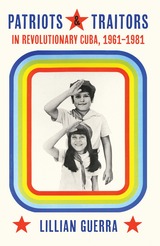 Patriots and Traitors in Revolutionary Cuba: 1961-1981
Lillian Guerra
University of Pittsburgh Press, 2023 Authorities in postrevolutionary Cuba worked to establish a binary society in which citizens were either patriots or traitors. This all-or-nothing approach reflected in the familiar slogan “patria o muerte” (fatherland or death) has recently been challenged in protests that have adopted the theme song “patria y vida” (fatherland and life), a collaboration by exiles that, predictably, has been banned in Cuba itself. Lillian Guerra excavates the rise of a Soviet-advised Communist culture controlled by state institutions and the creation of a multidimensional system of state security whose functions embedded themselves into daily activities and individual consciousness and reinforced these binaries. But despite public performance of patriotism, the life experience of many Cubans was somewhere in between. Guerra explores these in-between spaces and looks at Cuban citizens’ complicity with authoritarianism, leaders’ exploitation of an earnest anti-imperialist nationalism, and the duality of an existence that contains elements of both support and betrayal of a nation and of an ideology.
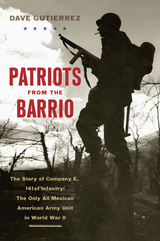 Patriots from the Barrio: The Story of Company E, 141st Infantry: The Only All Mexican American Army Unit in World War II
Dave Gutierrez
Westholme Publishing, 2018 Named One of the 24 Best History Books of All Time by Book Riot
The Inspiring True Story of a Segregated Unit Whose Exploits Underscore the Forgotten Latino Contribution to the Allied Victory in World War II
As a child, Dave Gutierrez hung on every word his father recalled about his cousin Ramon, “El Sancudo” (the mosquito), and his service in World War II, where he earned a Silver Star, three Purple Hearts, and escaped from the Germans twice. Later, Dave decided to find out more about his father’s cousin, and in the course of his research he discovered that Ramon Gutierrez was a member of Company E, 141st Infantry, a part of the 36th “Texas” Division that was comprised entirely of Mexican Americans—the only such unit in the entire U.S. Army. The division landed at Salerno, Italy, in 1943, among first American soldiers to set foot in Europe. In the ensuing months, Company E and the rest of the 36th would battle their way up the mountainous Italian peninsula against some of Nazi Germany’s best troops. In addition to the merciless rain, mud, and jagged peaks, swift cold rivers crisscrossed the region, including the Rapido, where Company E would face its greatest challenge. In an infamous episode, the 36th Division was ordered to cross the Rapido despite reports that the opposite bank was heavily defended. In the ensuing debacle, the division was ripped apart, and Company E sustained appalling casualties. The company rebounded and made the storied landings at Anzio and ultimately invaded southern France for a final push into Germany. The men of Company E distinguished themselves as rugged fighters capable of warring amid the rubble of destroyed villages and in the devastated countryside.
Based on extensive archival research and veteran and family accounts, Patriots from the Barrio: The Story of Company E, 141st Infantry: The Only All Mexican American Army Unit in World War II brings to life the soldiers whose service should never have gone unrecognized for so long. With its memorable personalities, stories of hope and immigration, and riveting battle scenes, this beautifully written book is a testament to the shared beliefs of all who have fought for the ideals of the American flag.
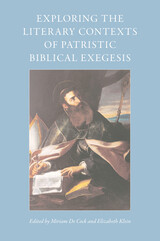 Patristic Exegesis in Context: Exploring the Genres of Early Christian Biblical Interpretation
Miriam De Cock
Catholic University of America Press, 2023 The essays of Patristic Exegesis in Context examine the biblical exegesis of early Christians beyond the formal genre of biblical commentary. The past couple of decades have seen a broadening of perspective on the study of patristic exegesis; the phenomenon is increasingly situated within its various literary contexts and genres, and the definition of what counts as patristic exegesis is therefore widened. This volume thus situates itself within this emerging scholarly tradition, which aims not to give an account of exegetical strategies and methodologies as found primarily in exegetical commentaries and homilies, but to demonstrate the highly sophisticated nature of biblical exegesis in other genres, and the manifold uses to which this exegesis was put. Ancient Christian authors lived and breathed scripture; it served as their primary source of theological and liturgical vocabulary, their way of processing the world, their social ethic, and their mode of constructing self and communal identity. Scripture therefore permeates all ancient Christian literature, regardless of genre, and the various contexts in which interpretation of scripture took place resulted in a wide variety of uses of the church’s authoritative texts. The essays in this volume demonstrate the interpretive skill, creativity, and sophistication of early Christian authors in a myriad of other early Christian genres, such as poetry, paraphrase, hymns, martyr accounts, homilies, prophetic vision accounts, monastic writings, argumentative treatises, encomia, apocalypses, and catenae. Accordingly, the volume aims to help the modern person, who is used to hearing the Bible explained in explicitly expository situations (for example, in academic commentaries or religious sermons) to become more habituated to ancient ways of interacting with and expounding the biblical text. These essays attempt to contextualize various types of patristic exegesis, in order for us to glimpse the complex and diverse uses of the Bible in this period.
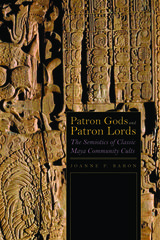 Patron Gods and Patron Lords: The Semiotics of Classic Maya Community Cults
Joanne Baron
University Press of Colorado, 2016 In the first comprehensive treatment of Classic Maya patron deity veneration, Joanne P. Baron demonstrates the central importance of patron deity cults in political relationships between both rulers and their subjects and among different Maya kingdoms. Weaving together evidence from inscriptions, images, and artifacts, Patron Gods and Patron Lords provides new insights into how the Classic Maya polity was organized and maintained.
Using semiotic theory, Baron draws on three bodies of evidence: ethnographies and manuscripts from Postclassic, Colonial, and modern Maya communities that connect patron saints to pre-Columbian patron gods; hieroglyphic texts from the Classic period that discuss patron deity veneration; and excavations from four patron deity temples at the site of La Corona, Guatemala. She shows how the Classic Maya used patron deity effigies, temples, and acts of devotion to negotiate group membership, social entitlements, and obligations between individuals and communities. She also explores the wider role of these processes in politics, arguing that rituals and discourses related to patron deities ultimately formulated Maya rulership as a locally oriented institution, which limited the ability of powerful kingdoms to create wider religious communities.
Applying a new theoretical approach for the archaeological study of ideology and power dynamics, Patron Gods and Patron Lords reveals an overlooked aspect of the belief system of Maya communities.
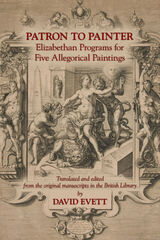 Patron to Painter: Elizabethan Programs for Five Allegorical Paintings
David Evett
Arizona Center for Medieval and Renaissance Studies, 2020 For more than two centuries the group of early modern English manuscripts presented in this volume sat mostly ignored on the shelves of the British Library, known only to the librarians who catalogued them. Six of them, for four different elaborate allegorical paintings, appear in the manuscript catalog of the Sloane Collection as “Instructions to painters.” A seventh, from the Harley collection in the same library, has more recently been added to the group. On art historical, iconographic, and historical grounds the manuscripts add significantly to our knowledge of Elizabethan visual allegory, and reveal a provocative new contribution to the evolution of English political thought. And the development across three of the programs of a warm personal relationship between the patron and the artist opens a unique window into early modern relationships of this kind. Unlike most other surviving artistic programs, this one reveals its author’s personality and interests in a rich and beguiling way, and although as a writer he is no Sidney or Nashe, the naïve yet widely informed enthusiasm with which he addresses his readers has considerable force and charm.
Pattern and Loom: A Practical Study of the Development of Weaving Techniques in China, Western Asia and Europe
John Becker
National University of Singapore Press, 2014 When John Becker's Pattern and Loom was posthumously published in 1987, the work was hailed as an important work that revealed much new knowledge on the development of weaving techniques across the centuries from China through to Europe. The key to the book's almost forensic investigation of its subject was the author himself, a Danish damask weaver with a lifetime's practical experience in his craft and an intimate knowledge of weaving techniques that allowed him to decipher, experiment and interpret original techniques from small remnants of surviving material. Long out of print, the work has been tidied and reset by Becker's collaborator on the original work, the sinologist Don Wagner.
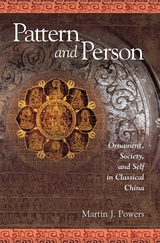 Pattern and Person: Ornament, Society, and Self in Classical China
Martin J. Powers
Harvard University Press, 2006 In Classical China, crafted artifacts offered a material substrate for abstract thought as graphic paradigms for social relationships. Focusing on the fifth to second centuries B.C., Martin Powers explores how these paradigms continued to inform social thought long after the material substrate had been abandoned. In this detailed study, the author makes the claim that artifacts are never neutral: as a distinctive possession, each object—through the abstracting function of style—offers a material template for scales of value. Likewise, through style, pictorial forms can make claims about material “referents,” the things depicted. By manipulating these scales and their referents, artifacts can shape the way status, social role, or identity is understood and enforced. The result is a kind of “spatial epistemology” within which the identities of persons are constructed. Powers thereby posits a relationship between art and society that operates at a level deeper than iconography, attributes, or social institutions.
Historically, Pattern and Person traces the evolution of personhood in China from a condition of hereditary status to one of achieved social role and greater personal choice. This latter development, essential for bureaucratic organization and individual achievement, challenges the conventional opposition between “Western” individuals and “collective” Asians.
 Pattern and Repertoire in History
Bertrand M. Roehner and Tony Syme
Harvard University Press, 2002 Historical landmarks, such as wars, coups, and revolutions, seem to arise under unique conditions. Indeed, what seems to distinguish history from the natural and social sciences is its inability to be dissected or generalized in any meaningful way. Yet even complex and large-scale events like the American Revolutionary War and the French Revolution can be broken down into their component parts, and, as Bertrand Roehner and Tony Syme show, these smaller modules are rarely unique to the events they collectively compose.
The aim of this book is to analyze clusters of similar "elementary" occurrences that serve as the building blocks of more global events. Making connections between seemingly unrelated case studies, Roehner and Syme apply scientific methodology to the analysis of history. Their book identifies the recurring patterns of behavior that shape the histories of different countries separated by vast stretches of time and space. Taking advantage of a broad wealth of historical evidence, the authors decipher what may be seen as a kind of genetic code of history.
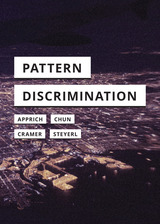 Pattern Discrimination
Clemens Apprich
University of Minnesota Press, 2018 How do “human” prejudices reemerge in algorithmic cultures allegedly devised to be blind to them? How do “human” prejudices reemerge in algorithmic cultures allegedly devised to be blind to them? To answer this question, this book investigates a fundamental axiom in computer science: pattern discrimination. By imposing identity on input data, in order to filter—that is, to discriminate—signals from noise, patterns become a highly political issue. Algorithmic identity politics reinstate old forms of social segregation, such as class, race, and gender, through defaults and paradigmatic assumptions about the homophilic nature of connection. Instead of providing a more “objective” basis of decision making, machine-learning algorithms deepen bias and further inscribe inequality into media. Yet pattern discrimination is an essential part of human—and nonhuman—cognition. Bringing together media thinkers and artists from the United States and Germany, this volume asks the urgent questions: How can we discriminate without being discriminatory? How can we filter information out of data without reinserting racist, sexist, and classist beliefs? How can we queer homophilic tendencies within digital cultures?
The Pattern More Complicated: New and Selected Poems
Alan Williamson
University of Chicago Press, 2004 Alan Williamson artfully joins social and literary history with personal experience in The Pattern More Complicated, a collection of his very best poems over the last twenty years. A powerful section of new poems draws the whole work together in a kind of autobiographical novel, as—in Eliot's phrase, from which the title is taken—"the pattern of dead and living" grows "more complicated" with the years. Williamson's verse is a refreshing examples of how delicately the personal can intersect with the public in a love for the considered life.
The Pattern More Complicated assembles Williamson's most important, representative poems, marking the trajectory of poetic development and the recurrence of themes across the span of four previous collections to present a survey of a major American poet in a single volume.
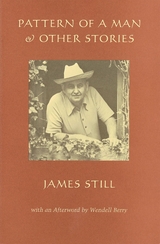 Pattern of a Man and Other Stories
James Still
Ohio University Press Published in 2001 by Gnomon Press This reissue of a 1976 collection, featuring a new afterword by Wendell Berry, showcases James Still’s enduring mastery of the short story form. Set in the Appalachian region, these twelve stories reflect the rhythms, dialects, and deep-rooted traditions of mountain life, rendered with quiet power and poetic precision. Still’s characters—rural craftsmen, widows, children, and wanderers—navigate the complexities of isolation, kinship, and survival. Stories like “The Nest,” “The Scrape,” and “Maybird Upshaw” reveal a landscape both stark and tender, where the natural world and human spirit intertwine. With language shaped by the unique dialect of eastern Kentucky, Still’s prose honors the dignity of his subjects without sentimentality or condescension. This collection affirms Still’s place among the great chroniclers of American regional life, offering readers a poignant and authentic portrait of a vanishing world.
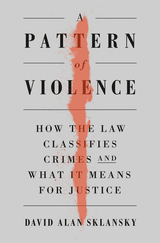 A Pattern of Violence: How the Law Classifies Crimes and What It Means for Justice
David Alan Sklansky
Harvard University Press, 2021 A law professor and former prosecutor reveals how inconsistent ideas about violence, enshrined in law, are at the root of the problems that plague our entire criminal justice system—from mass incarceration to police brutality.
We take for granted that some crimes are violent and others aren’t. But how do we decide what counts as a violent act? David Alan Sklansky argues that legal notions about violence—its definition, causes, and moral significance—are functions of political choices, not eternal truths. And these choices are central to failures of our criminal justice system.
The common distinction between violent and nonviolent acts, for example, played virtually no role in criminal law before the latter half of the twentieth century. Yet to this day, with more crimes than ever called “violent,” this distinction determines how we judge the seriousness of an offense, as well as the perpetrator’s debt and danger to society. Similarly, criminal law today treats violence as a pathology of individual character. But in other areas of law, including the procedural law that covers police conduct, the situational context of violence carries more weight. The result of these inconsistencies, and of society’s unique fear of violence since the 1960s, has been an application of law that reinforces inequities of race and class, undermining law’s legitimacy.
A Pattern of Violence shows that novel legal philosophies of violence have motivated mass incarceration, blunted efforts to hold police accountable, constrained responses to sexual assault and domestic abuse, pushed juvenile offenders into adult prisons, encouraged toleration of prison violence, and limited responses to mass shootings. Reforming legal notions of violence is therefore an essential step toward justice.
A Patterned Past: Form and Thought in Early Chinese Historiography
David Schaberg
Harvard University Press, 2001 In this comprehensive study of the rhetoric, narrative patterns, and intellectual content of the Zuozhuan and Guoyu, David Schaberg reads these two collections of historical anecdotes as traces of a historiographical practice that flourished around the fourth century BCE among the followers of Confucius. He contends that the coherent view of early China found in these texts is an effect of their origins and the habits of reading they impose. Rather than being totally accurate accounts, they represent the efforts of a group of officials and ministers to argue for a moralizing interpretation of the events of early Chinese history and for their own value as skilled interpreters of events and advisers to the rulers of the day.
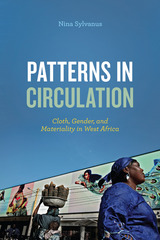 Patterns in Circulation: Cloth, Gender, and Materiality in West Africa
Nina Sylvanus
University of Chicago Press, 2016 In this book, Nina Sylvanus tells a captivating story of global trade and cross-cultural aesthetics in West Africa, showing how a group of Togolese women—through the making and circulation of wax cloth—became influential agents of taste and history. Traveling deep into the shifting terrain of textile manufacture, design, and trade, she follows wax cloth around the world and through time to unveil its critical role in colonial and postcolonial patterns of exchange and value production.
Sylvanus brings wax cloth’s unique and complex history to light: born as a nineteenth-century Dutch colonial effort to copy Javanese batik cloth for Southeast Asian markets, it was reborn as a status marker that has dominated the visual economy of West African markets. Although most wax cloth is produced in China today, it continues to be central to the expression of West African women’s identity and power. As Sylvanus shows, wax cloth expresses more than this global motion of goods, capital, aesthetics, and labor—it is a form of archive where intimate and national memories are stored, always ready to be reanimated by human touch. By uncovering this crucial aspect of West African material culture, she enriches our understanding of global trade, the mutual negotiations that drive it, and the how these create different forms of agency and subjectivity.
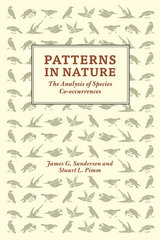 Patterns in Nature: The Analysis of Species Co-Occurrences
James G. Sanderson and Stuart L. Pimm
University of Chicago Press, 2015 What species occur where, and why, and why some places harbor more species than others are basic questions for ecologists. Some species simply live in different places: fish live underwater; birds do not. Adaptations follow: most fish have gills; birds have lungs. But as Patterns in Nature reveals, not all patterns are so trivial.
Travel from island to island and the species change. Travel along any gradient—up a mountain, from forest into desert, from low tide to high tide on a shoreline —and again the species change, sometimes abruptly. What explains the patterns of these distributions? Some patterns might be as random as a coin toss. But as with a coin toss, can ecologists differentiate associations caused by a multiplicity of complex, idiosyncratic factors from those structured by some unidentified but simple mechanisms? Can simple mechanisms that structure communities be inferred from observations of which species associations naturally occur? For decades, community ecologists have debated about whether the patterns are random or show the geographically pervasive effect of competition between species. Bringing this vigorous debate up to date, this book undertakes the identification and interpretation of nature’s large-scale patterns of species co-occurrence to offer insight into how nature truly works.
Patterns in Nature explains the computing and conceptual advances that allow us to explore these issues. It forces us to reexamine assumptions about species distribution patterns and will be of vital importance to ecologists and conservationists alike.
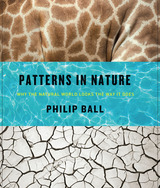 Patterns in Nature: Why the Natural World Looks the Way It Does
Philip Ball
University of Chicago Press, 2016 Though at first glance the natural world may appear overwhelming in its diversity and complexity, there are regularities running through it, from the hexagons of a honeycomb to the spirals of a seashell and the branching veins of a leaf. Revealing the order at the foundation of the seemingly chaotic natural world, Patterns in Nature explores not only the math and science but also the beauty and artistry behind nature’s awe-inspiring designs.
Unlike the patterns we create in technology, architecture, and art, natural patterns are formed spontaneously from the forces that act in the physical world. Very often the same types of pattern and form – spirals, stripes, branches, and fractals, say—recur in places that seem to have nothing in common, as when the markings of a zebra mimic the ripples in windblown sand. That’s because, as Patterns in Nature shows, at the most basic level these patterns can often be described using the same mathematical and physical principles: there is a surprising underlying unity in the kaleidoscope of the natural world. Richly illustrated with 250 color photographs and anchored by accessible and insightful chapters by esteemed science writer Philip Ball, Patterns in Nature reveals the organization at work in vast and ancient forests, powerful rivers, massing clouds, and coastlines carved out by the sea.
By exploring similarities such as those between a snail shell and the swirling stars of a galaxy, or the branches of a tree and those of a river network, this spectacular visual tour conveys the wonder, beauty, and richness of natural pattern formation.
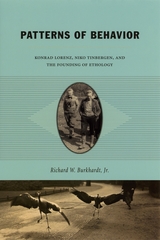 Patterns of Behavior: Konrad Lorenz, Niko Tinbergen, and the Founding of Ethology
Richard W. Burkhardt, Jr.
University of Chicago Press, 2005 It is hard to imagine, by their very name, the life sciences not involving the study of living things, but until the twentieth century much of what was known in the field was based primarily on specimens that had long before taken their last breaths. Only in the last century has ethology—the study of animal behavior—emerged as a major field of the life sciences.
In Patterns of Behavior, Richard W. Burkhardt Jr. traces the scientific theories, practices, subjects, and settings integral to the construction of a discipline pivotal to our understanding of the diversity of life. Central to this tale are Konrad Lorenz and Niko Tinbergen, 1973 Nobel laureates whose research helped legitimize the field of ethology and bring international attention to the culture of behavioral research. Demonstrating how matters of practice, politics, and place all shaped "ethology's ecologies," Burkhardt's book offers a sensitive reading of the complex interplay of the field's celebrated pioneers and a richly textured reconstruction of ethology's transformation from a quiet backwater of natural history to the forefront of the biological sciences. Winner of the 2006 Pfizer Awad from the History of Science Society
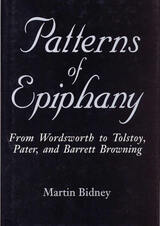 Patterns of Epiphany: From Wordsworth to Tolstoy, Pater, and Barrett Browning
Martin Bidney
Southern Illinois University Press, 1997
After explaining his new methodology, Bidney identifies and discusses epiphanies in the works of William Wordsworth, Samuel Taylor Coleridge, Matthew Arnold, Alfred Lord Tennyson, Walter Pater, Thomas Carlyle, Leo Tolstoy, and Elizabeth Barrett Browning. Taking his cue from the French philosopher Gaston Bachelard, Bidney postulates that any writer’s epiphany pattern usually shows characteristic elements (earth, air, fire, water), patterns of motion (pendular, eruptive, trembling), and/or geometric shapes. Bachelard’s analytic approach involves studying patterns of perceived experience—phenomenology—but unlike most phenomenologists, Bidney does not speculate on internal processes of consciousness. Instead, he concentrates on literary epiphanies as objects on the printed page, as things with structures that can be detected and analyzed for their implications.
Bidney, then, first identifies each author’s paradigm epiphany, finding that both the Romantics and the Victorians often label such a paradigm as a vision or dream, thereby indicating its exceptional intensity, mystery, and expansiveness. Once he identifies the paradigm and shows how it is structured, he traces occurrences of each writer’s epiphany pattern, thus providing an inclusive epiphanic portrait that enables him to identify epiphanies in each writer’s other works. Finally, he explores the implications of his analysis for other literary approaches: psychoanalytical, feminist, influence-oriented or intertextual, and New Historical.
Patterns of Hospital Ownership and Control
James Hamilton
University of Minnesota Press, 1961
Patterns of Hospital Ownership and Control was first published in 1961.Based on a study of data about nearly 7,000 independent unites of hospital service in the United States, this book classifies and describes the patterns or types of hospital ownership and control to be found in the hospital industry. For each pattern, information is given on the organizational structure and governing authority, history, significance, finances, educational activities, administration, medical staff, groups or associations within the pattern, and future trends. The book will enable students of hospital administration to get an overall view of the hospital industry and a familiarity with the groups responsible for hospital care. It will be useful, also, as a reference work for hospital administrators.
 Patterns of Human Variation: The Demography, Genetics, and Phenetics of Bougainville Islanders
Jonathan S. Friedlaender
Harvard University Press, 1975 This uniquely comprehensive study analyzes genetic and cultural variation in a human population of extraordinary diversity. The author measures the relationship between patterns of biological and patterns of cultural variation as a way to test the contribution made by natural selection to genetic variability. If linguistic similarity and migration history serve to predict biological patterns, support is provided for the hypothesis that forces other than natural selection are responsible for the diversity observed.
The data for this study come from a group of eighteen villages located in eight neighboring language areas that are clustered in a small region of Bougainville Island, Papua New Guinea. Biological and anthropological data are analyzed with a battery of sophisticated statistical and taxonomic methods: multiple discriminant analyses, principal coordinates analyses, principal components analyses, and Gower's R2 comparison. Diverse biological properties of the Bougainville Islanders prove to be closely related to their patterns of migration. Although this result in no way refutes the role of natural selection in the evolutionary process, it highlights the extent to which genetic diversity can be molded, at least in human populations, by nonselective events.
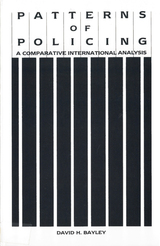 Patterns of Policing: A Comparative International Analysis
Bayley, David
Rutgers University Press, 1990 "Patterns of Policing" is the first comparison of the development and operation of police in countries throughout the world, concentrating on Asia, Europe, and North America. Bayley examines the variability in police work, suggests reasons for this variation, and makes preditions about the future role of police. He considers how contemporary police institutions have developed. Police forces worldwide tend to be public rather than private, to concentrate on crime fighting rather than services, and to be professionally trained and recruited. There is, however, great variation in the structure of police forces, which are generally either centralized or, as in the United States, decentralized. The behavior of the police toward their constituents also varies by nation. As urbanization and industrialization increase, the public finds itself in greater contact with police and may begin to rely on them more for protection. There are also marked differences cross-nationally in the way police relate to political and community life.
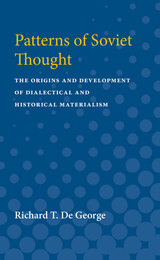 Patterns of Soviet Thought: The Origins and Development of Dialectical and Historical Materialism
Richard T. De George
University of Michigan Press, 1966 Marxism-Leninism as a way of thinking is foreign to most Westerners, but it permeates the thought of nearly a third of educated mankind. Patterns of Soviet Thought traces the development of the Marxist-Leninist philosophy, clarifies its meaning in theory and practice, and emphasizes its position in the Soviet Union. Based on the writings of Marx, Engels, and Lenin and on contemporary Soviet writings, this book reveals the basic patterns that make up the modern Soviet worldview.How can both the Chinese and the Soviets quote Lenin to support opposing positions? How could an educated Soviet citizen accept the official about-face concerning Stalin? How can the same citizen condemn the United States morally while admiring many of its citizens and emulating its standard of living? To answer questions like these we need to understand the ambiguities and contradictions of Soviet thought. They are its philosophical Achilles' heel, but they also help to shape it and give it resiliency in the face of facts.Written for the intelligent general reader, Patterns of Soviet Thought summarizes the works of major and minor philosophers from Marx to the present and offers a detailed critique of their important ideas. It provides the basis for an understanding of present-day Soviet policies and of the developments that are to mold the future course of the Soviet Union.
 Patterns of Time in Hospital Life: A Sociological Perspective
Eviatar Zerubavel
University of Chicago Press, 1979 This volume presents an original study in the sociology of time: a case-description and conceptual analysis of the ways in which the temporal frameworks we customarily take for granted structure social reality. The study is based on the author's observation of the activities of medical professionals in a large teaching hospital: there, he collected data to show that the rhythms of organizational life have particular moral and cognitive dimensions, beyond simple regulative functions. While individuals customarily adapt to a variety of contexts for anchoring events in time, the temporal coordination necessary for collective efforts enforces social controls at multiple levels. This "sociotemporal order," an inherent constituent of social life, offers researchers and theoreticians alike a fresh and rewarding analytic perspective.
Patterns of Time will be valued for its several distinctive achievements. Foremost among these is a demonstration of the importance of "temporality" as a topic in its own right. Because measurements of time are a commonplace of social life, sociologists have tended to ignore the significance of temporality as a feature of social organizations. Zerubavel's work is a corrective to this neglect. In addition, the author's imaginative integration of ethnographic description and theoretical analysis bridges the gap between contrasting methods that has characterized much recent sociological and anthropological work. Finally, because of the author's selection of the hospital setting, sociologists of medicine and the professions will find his study useful for its rich and well-observed ethnography, as well as its novel analytical approach.
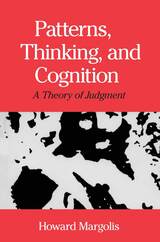 Patterns, Thinking, and Cognition: A Theory of Judgment
Howard Margolis
University of Chicago Press, 1988 What happens when we think? How do people make judgments? While different theories abound—and are heatedly debated—most are based on an algorithmic model of how the brain works. Howard Margolis builds a fascinating case for a theory that thinking is based on recognizing patterns and that this process is intrinsically a-logical. Margolis gives a Darwinian account of how pattern recognition evolved to reach human cognitive abilities.
Illusions of judgment—standard anomalies where people consistently misjudge or misperceive what is logically implied or really present—are often used in cognitive science to explore the workings of the cognitive process. The explanations given for these anomalous results have generally explained only the anomaly under study and nothing more. Margolis provides a provocative and systematic analysis of these illusions, which explains why such anomalies exist and recur.
Offering empirical applications of his theory, Margolis turns to historical cases to show how an individual's cognitive repertoire—the available cognitive patterns and their relation to cues—changes or resists changes over time. Here he focuses on the change in worldview occasioned by the Copernican discovery: not only how an individual might come to see things in a radically new way, but how it is possible for that new view to spread and become the dominant one. A reanalysis of the trial of Galileo focuses on social cognition and its interactions with politics.
In challenging the prevailing paradigm for understanding how the human mind works, Patterns, Thinking, and Cognition is certain to stimulate fruitful debate.
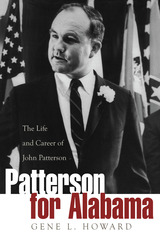 Patterson for Alabama: The Life and Career of John Patterson
Gene Howard
University of Alabama Press, 2013 John Patterson, Alabama governor from 1959 to 1963, was thrust into the Alabama political arena after the brutal murder of his father, attorney general Albert Patterson in 1954. Allowed by the Democratic Party to take his father’s place and to complete the elder’s goal of cleaning up corruption in his hometown Phenix City, Patterson made a young, attractive, and sympathetic candidate. Patterson for Alabama details his efforts to clean up his hometown, oppose corruption in the administration of Governor Big Jim Folsom, and to resist school desegregation. Popular on all three counts, Patterson went on to defeat rising populist George Wallace for governor. Patterson’s term as governor was marked by rising violence as segregationists violently resisted integration. His role as a champion of resistance has clouded his reputation to this day. Patterson left office with little to show for f his efforts and opposed for one reason or another by nearly all sectors of Alabama. Stymied in efforts to reclaim the governorship or a seat on the Alabama state Supreme Court, Patterson was appointed by Wallace to the state court of criminal appeals in 1984 and served on that body until retiring in 1997. In 2004, he served as one of the justices who removed the Chief Justice of the Alabama Supreme Court Roy Moore for ignoring a federal court order.
Patton: Battling with History
J. Furman Daniel
University of Missouri Press, 2025 General George S. Patton Jr. is one of the most successful yet misunderstood figures in American military history. Despite the many books and articles written about him, none considers in depth how his love of history shaped the course of his life. In this thematic biography, Furman Daniel traces Patton’s obsession with history and argues that it informed and contributed to many of his successes, both on and off the battlefield.
Patton deliberately cultivated the image of himself as a warrior from ages past; the more interesting truth is that he was an exceptionally dedicated student of history. He was a hard worker and voracious reader who gave a great deal of thought to how military history might inform his endeavors. Most scholars have overlooked this element of Patton’s character, which Daniel argues is essential to understanding the man’s genius.
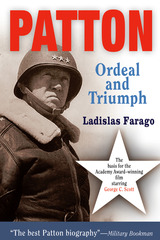 Patton: Ordeal and Triumph
Ladislas Farago
Westholme Publishing, 2005 "The best Patton biography."—Military Bookman He is America's most famous general. He represents toughness, focus, determination, and the ideal of achievement in the face of overwhelming odds. He was the most feared and respected adversary to his enemies and an object of envy, admiration, and sometimes, scorn to his professional peers. An early proponent of tank warfare, George S. Patton moved from being a foresighted lieutenant in the First World War to commanding the Third Army in the next, leading armored divisions in the Allied offensive that broke the back of Nazi Germany. Patton was an enigmatic figure. His image among his troops and much of the press achieved legendary status through his bold and colorful comments and combat leadership, yet these same qualities nearly jeopardized his career and forced him out of the battle on several occasions. Victory was impossible without Patton, and returning to the field, his army was responsible for one of the most crushing advances in the history of warfare. In Ladislas Farago's masterpiece, Patton: Ordeal and Triumph, the complete story of this fascinating personality is revealed. Born into an aristocratic California family, Patton rose in military rank quickly and was tapped to lead the Allied landings in North Africa in 1942. Under Patton's direction, American troops cut their teeth against Rommel's Afrikakorps, advanced further and more quickly than British General Montgomery's army in the conquest of Sicily, and ultimately continued their exploits by punching into Germany and checking the Russian westward advance at the end of World War II. A sweeping, absorbing biography and critically hailed, Patton: Ordeal and Triumph provides unique insights into Patton's life and leadership style and is military history at its finest.
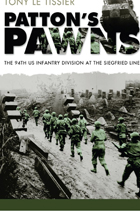 Patton's Pawns: The 94th US Infantry Division at the Siegfried Line
Tony Le Tissier
University of Alabama Press, 2007 The 94th US Infantry Division was an organization formed late in the Second World War, made up largely of draft-deferred university students as enlisted men and an officer corps pulled together from various domestic postings with unfortunate consequences for mutual trust and respect.
Initially used as part of the force blockading the Brittany ports after D-Day, in December of 1944, the division was incorporated into General Patton’s Third Army south of the Moselle-Saar Triangle, the base of which was a portion of the Siegfried Line known as the Orscholz Switch. Its first combat experience came in battalion-sized attacks during that terrible winter while the Battle of the Bulge raged to the north, and the Division suffered heavy casualties, many due to the ferocity of the winter weather. Patton, with characteristic zeal, excoriated the division’s officers and senior NCOs for the rate of non-combat casualties. Thereafter, the division was ordered forward on an all-out assault to break through the Siegfried Line. After horrific fighting against entrenched defenders, with ice turning to mud as spring approached, on February 19, 1945, the 94th broke through to open the roads to Trier and the Rhine.
This book is the most comprehensive study to date of the fierce fighting between the 94th U.S. Infantry Division and their German counterparts during that spring of 1945. It sheds new light on the achievements of the outnumbered division in penetrating Germany’s Westwall. With characteristic verve and detail, Tony Le Tissier narrates the action and illuminates the tribulations and sacrifices of American soldiers who won their laurels at great cost.
Patton's Shadow: The Making of a Hero in Modern Memory
Nathan C. Jones
University of Alabama Press, 2024 General George S. Patton’s legendary image was carefully crafted during World War II and continues to shape our understanding of American history and culture today. Historian Nathan C. Jones explores the creation of the Patton legend and its enduring legacy in Patton’s Shadow.
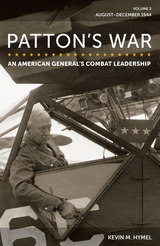 Patton's War: An American General's Combat Leadership, Volume 2: August–December 1944
Kevin M. Hymel
University of Missouri Press, 2023 Winner of the 2023 Army Historical Foundation Distinguished Writing Award for Biography
Finalist for the 2023 Gilder Lehrman Military History Prize
This second of three volumes of Patton’s War picks up where the first one left off, examining General George S. Patton’s leadership of the U.S. Third Army. The book follows Patton’s contributions to both the Normandy and Brittany campaigns—the closing of the Falaise Pocket in Normandy, and racing to the port cities in Brittany. It ends with Patton and his corps rescuing the besieged town of Bastogne in the Battle of the Bulge.
As he did in the preceding volume, Hymel relies not only on Patton’s diaries and letters, but countless veteran interviews, surveys, and memoirs. He also provides a unique insight missed by previous Patton scholars. Instead of using Patton’s transcribed diaries, which were heavily edited and embellished, he consults Patton’s original, hand-written diaries to uncover previously unknown information about the general.
This second volume of Hymel’s groundbreaking work shows Patton at the height of his generalship, successfully leading his army without the mistakes and caustic behavior that almost got him sent home earlier—even if we also see a Patton still guided at times by racism and antisemitism.
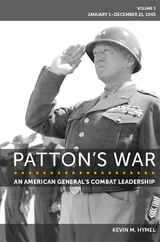 Patton's War: An American General's Combat Leadership Volume 3: January 1-December 21, 1945
Kevin M. Hymel
University of Missouri Press, 2026 The third and final volume of Kevin Hymel’s Patton’s War trilogy finds Lieutenant General George S. Patton on January 1, 1945, as the master of the battlefield in World War II Europe. Throughout the war, Patton showed the same kind of aggressive leadership and battlefield smarts that made his name synonymous with victory. Patton’s leadership was almost flawless as he led his men through enemy fire and one of the worst winters in European history.
As with his previous volume, Hymel relies on Patton’s original diaries (not the transcribed, embellished versions historians have relied on for many years) and personal letters to tell the general’s story. Hymel also mined various archives to explain Patton’s encounters with soldiers, government officials, civilians, and reporters to expand on his narrative.
Throughout this three-volume work, Patton emerges not as a larger-than-life myth, but as a human being, one held back by the personal prejudices and antisemitism that ultimately proved to be his demise. Despite these personal failings, Patton was, above all, as Hymel reveals, a commander bent on winning, or, as the general himself might have put it, getting the enemy to dance to his tune.
Patton's War: An American General's Combat Leadership, Volume I: November 1942–July 1944
Kevin M. Hymel
University of Missouri Press, 2021 George S. Patton Jr. lived an exciting life in war and peace, but he is best remembered for his World War II battlefield exploits. Patton’s War: An American General’s Combat Leadership: November 1942–July 1944, the first of three volumes, follows the general from the beaches of Morocco to the fields of France, right before the birth of Third Army on the continent. In highly engaging fashion, Kevin Hymel uncovers new facts and challenges long-held beliefs about the mercurial Patton, not only examining his relationships with his superiors and fellow generals and colonels, but also with the soldiers of all ranks whom he led. Using new sources unavailable to previous historians and through extensive research of soldiers’ memoirs and interviews, Hymel adds a new dimension to the telling of Patton’s WWII story.
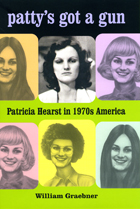 Patty's Got a Gun: Patricia Hearst in 1970s America
William Graebner
University of Chicago Press, 2008 It was a story so bizarre it defied belief: in April 1974, twenty-year-old newspaper heiress Patricia Hearst robbed a San Francisco bank in the company of members of the Symbionese Liberation Army—who had kidnapped her a mere nine weeks earlier. But the robbery—and the spectacular 1976 trial that ended with Hearst’s criminal conviction—seemed oddly appropriate to the troubled mood of the nation, an instant exemplar of a turbulent era. With Patty’s Got a Gun, the first substantial reconsideration of Patty Hearst’s story in more than twenty-five years, William Graebner vividly re-creates the atmosphere of uncertainty and frustration of mid-1970s America. Drawing on copious media accounts of the robbery and trial—as well as cultural artifacts from glam rock to Invasion of the Body Snatchers—Graebner paints a compelling portrait of a nation confused and frightened by the upheavals of 1960s liberalism and beginning to tip over into what would become Reagan-era conservatism, with its invocations of individual responsibility and the heroic. Trapped in the middle of that shift, the affectless, zombielike, “brainwashed” Patty Hearst was a ready-made symbol of all that seemed to have gone wrong with the sixties—the inevitable result, some said, of rampant permissiveness, feckless elitism, the loss of moral clarity, and feminism run amok. By offering a fresh look at Patty Hearst and her trial—for the first time free from the agendas of the day, yet set fully in their cultural context—Patty’s Got a Gun delivers a nuanced portrait of both an unforgettable moment and an entire era, one whose repercussions continue to be felt today.
Patty’s Journey: From Orphanage To Adoption And Reunion
Donna Scott Norling
University of Minnesota Press, 1998 The award-winning memoir of one woman’s struggles and triumphs to reclaim an identity she had lost. This inspirational story of one girl’s search for a home is an engaging first-person narrative of life during the Great Depression and World War II. Readers and critics alike offer lavish praise for Norling’s graceful, simple prose and the heartbreaking, ultimately redemptive tale she shares.
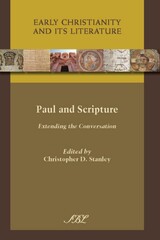 Paul and Scripture: Extending the Conversation
Christopher D. Stanley
SBL Press, 2012 This book, which grew out of the Society of Biblical Literature’s Paul and Scripture Seminar, explores some of the methodological problems that have arisen during the last few decades of scholarly research on the apostle Paul’s engagement with his ancestral Scriptures. Essays explore the historical backgrounds of Paul’s interpretive practices, the question of Paul’s “faithfulness” to the context of his biblical references, the presence of Scripture in letters other than the Hauptbriefe, and the role of Scripture in Paul’s theology. All of the essays look at old questions through new lenses in an effort to break through scholarly impasses and advance the debate in new directions. The contributors are Matthew W. Bates, Linda L. Belleville, Roy E. Ciampa, Bruce N. Fisk, Stephen E. Fowl, Leonard Greenspoon, E. Elizabeth Johnson, Mitchell M. Kim, Steve Moyise, Jeremy Punt, Christopher D. Stanley, and Jerry L. Sumney.
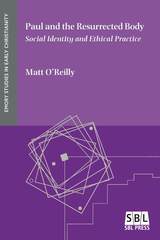 Paul and the Resurrected Body: Social Identity and Ethical Practice
Matt O'Reilly
SBL Press, 2020 A new reading of Pauline theology, ethics, and eschatology grounded in social-identity theory and sociorhetorical criticism
Readers often think of Paul’s attitude toward the resurrection of the body in individual terms: a single body raised as the climax of an individual’s salvation. In Paul and the Resurrected Body: Social Identity and Ethical Practice, Matt O’Reilly makes the case that, for Paul, the social dimension of future bodily resurrection is just as important, if not more so. Through a close reading of key texts in the letters to the Corinthians, Romans, and Philippians, O’Reilly argues that resurrection is integral to Paul’s understanding of Christian social identity. In Paul’s theological reasoning, a believer’s hope for the future depends on being identified as part of the people of God who will be resurrected.
Features
- A clarification of the eschatological basis for Paul’s ethical expectations
- Exploration of the social significance of Paul’s theological reasoning
- An integration of ancient rhetorical theory with contemporary social-identity theory
Paul as Infant and Nursing Mother: Metaphor, Rhetoric, and Identity in 1 Thessa
Jennifer Houston McNeel
SBL Press, 2014 Explore the significance of maternal metaphors in the writings of a first-century male missionary and theologian
Paul employed metaphors of childbirth or breastfeeding in four out of the seven undisputed epistles. In this book, McNeel uses cognitive metaphor theory and social identity analysis to examine the meaning and function of these maternal metaphors. She asserts that metaphors carry cognitive content and that they are central to how humans process information, construct reality, and shape group identity.
Features:
- A focus on “identity” as the way in which people understand themselves in relation to one another, to society, and to those perceived as outsiders
- Examination of metaphor as part of Paul’s rhetorical strategy
- Integration of the work of philosopher Max Black with the work of cognitive linguists George Lakoff and Mark Johnson
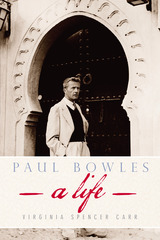 Paul Bowles: A Life
Virginia Spencer Carr
Northwestern University Press, 2008 Paul Bowles, best known for his classic 1949 novel, The Sheltering Sky, is one of the most compelling yet elusive figures of twentieth-century American counterculture. In this definitive biography, Virginia Spencer Carr has captured Bowles in his many guises: gifted composer, expatriate novelist, and gay icon, to name only a few. Born in New York in 1910, Bowles' brilliance was evident from early childhood. His first artistic interest was music, which he studied with the composer Aaron Copland. Bowles wrote scores for films and countless plays, including pieces by Tennessee Williams and Orson Welles. Over the course of his life, his intellectual pursuits led him around the world. He cultivated a circle of artistic friends that included Gertrude Stein, W.H. Auden, Gore Vidal, Truman Capote, Allen Ginsburg, William Burroughs, Stephen Spender, and Carson McCullers. Just as fascinating for his flamboyant personality as for his literary success, Bowles' leftist politics and experimentation with drugs make him an ever-controversial character. Carr delves into Bowles' unconventional marriage to Jane Auer and his self-exile in Morocco. Close friends with him before his death in 1999, Carr's first-hand knowledge of Bowles is undeniable. This book encompasses her personal experiences plus ten years of research and interviews with some two hundred of Bowles' acquaintances. Virginia Spencer Carr has written a riveting biography that tells not only the story of Paul Bowles' literary genius, but also of a crucial period of redefinition in American culture. Carr is simultaneously entertaining and precise, delivering a wealth of information on one of the most mythologized figures of mid-century literature.
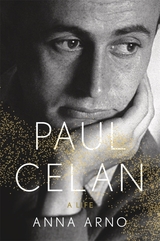 Paul Celan: A Life
Anna Arno
Harvard University Press A luminous, groundbreaking biography of one of the most important literary figures of the twentieth century, best known for the poem “Death Fugue.”
Paul Celan (1920–1970) was recognized as the greatest poet of the German language shortly before his tragic death just shy of his fiftieth birthday, when he drowned himself in the Seine. He described his “Todesfuge” (“Death Fugue”) as a “tombstone” for his mother, who perished in the Holocaust. Celan’s work is often viewed as a rejoinder to Theodor Adorno’s dictum that it was barbaric to write poetry after Auschwitz.
While the commentary on Celan’s contributions to poetics and Holocaust literature is voluminous, little has been written about his life itself. Anna Arno provides the definitive biography. Paul Celan: A Life follows the poet from his birthplace, Czernowitz (today Chernivtsi, Ukraine), to Bucharest, where he was part of an important circle of Surrealists, then onto Vienna, where he met and fell in love with Ingeborg Bachmann, and finally to Paris. Although in his final years he was haunted by bouts of mental illness, his life cannot be defined by its implosion. Paul Celan was an ardent, inveterate romantic whose many meaningful relationships left their mark on his poetry. He also cultivated intense, often fraught dialogues with such thinkers as René Char, Yves Bonnefoy, and Martin Heidegger.
Drawing upon a linguistically wide range of archival sources and the most up-to-date research, Arno presents a complete picture of Celan’s life. Here is the essential story of a towering figure in modern poetry.
 Paul Cullen, John Henry Newman, and the Catholic University of Ireland, 1845-1865
Colin Barr
University of Notre Dame Press, 2003 "This is a fine and impressive piece of work that makes an original contribution to nineteenth-century Irish history generally and to Irish education specifically. It will be welcomed by scholars who seek information about this important episode of Irish history." --Senia Paseta, St. Hugh's College, Oxford University
The history of the Catholic University of Ireland has long been overshadowed by the personality and writings of its first rector, John Henry Newman. Newman, author of the renowned The Idea of a University, played a vital role in the foundation of the university. But Colin Barr's new study paints a richer portrait of CUI's history by focusing on the university itself and on the influence of its founder Paul Cullen, archbishop of Armagh and then Dublin.
Most historians have based their treatments of the Catholic University of Ireland on Newman's own voluminous correspondence and later writings and have tended uncritically to accept Newman's own understanding of his role in Dublin and his relationship with Cullen. Newman has been cast in the role of a liberal, creative visionary who was frustrated at every turn by the obscurantist, ultramontane Cullen. Barr seeks to reassess Cullen's role in the founding and history of the University by utilizing previously unavailable sources and by relocating the history of the Catholic University in its Irish context.
Paul Cullen, John Henry Newman, and the Catholic University of Ireland, 1845-1865 presents a balanced treatment of both the university and of Newman and Cullen's roles in its history. The resulting text is a fascinating story of determination, conflict, and failure.
COLIN BARR lectures in modern European history at the National University of Ireland, Maynooth.
----------
"This is an excellent book, based on careful and detailed inquiry. Though derived from a thesis, it is written with clarity and fluency. It tells a new story, or rather is an example of historical revisionism at its best, with an new and more truthful story emerging to replace the old and tendentious one. To everyone interested in in both the history of Irish education, and the complexities of Ireland in the 19th century, Barr's book will be of immense interest and value." --Irish Catholic
"Barr has revisited the history of the university, making use of numerous sources which have only been opened to scholars in recent years. This enables Barr to re-draw the portrait often painted of Cullen as obscurantist and Newman as incompetent administrator and to provide a more balanced assessment of the efforts of both men to found CUI--a worthy project which the conditions of the time doomed to failure." --Catholic Library World
"Barr's work convincingly revises readers' understanding of the formation of the Catholic University of Ireland, giving Cullen credit for his stewardship of what traditionally has been labeled Newman's University. Colin Barr has written an outstanding book, essential reading for scholars and advanced students interested in the Catholic Church and higher education in nineteenth-century Ireland." --History: Reviews of New Books
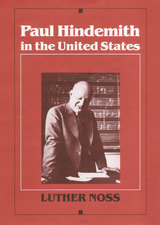 Paul Hindemith in the United States
Luther Noss
University of Illinois Press, 1989 Paul Hindemith (1895–1963) was one of the most influential musicians and composers of the twentieth century. His wide-ranging musical interests and prodigious gifts connected him to music as varied as neoclassicism, the avant garde, and chamber pieces for unusual groupings of instruments. The uncertainties of life under the Nazi regime led Hindemith to move to the United States in 1940. There, he taught at Yale University and composed celebrated works like Symphonic Metamorphosis of Themes by Carl Maria von Weber. Concentrating upon the composer's first three US concert tours and his thirteen years at Yale, Luther Noss brings to life a observant, energetic, stubborn, and wry personality. Hindemith's journals offer detailed commentary on his experiences at Tanglewood while Noss draws on archives to describe the composer's groundbreaking Collegium concerts, classes, controversial plans to reorganize the School of Music, and other activities. Noss also delves into professional activity that included a huge number of commissions, writing four theory textbooks, an expansion of his Charles Eliot Norton Lectures, and numerous world premieres and other events.
Paul Hymans: Belgium
Sally Marks
Haus Publishing, 2010 Paul Hymans was the champion of the small states in the League of Nations Commission at the Paris Peace Conference and was rewarded by becoming the League's first president. He thereby brought about Belgium's transition from the status of sheltered child to full participation in much great-power diplomacy.
Paul I: A Reassessment of His Life and Reign
Hugh Ragsdale
University of Pittsburgh Press, 1979
This book offers the first book-length English language biography of Russian emperor Paul I (1754–1801), since a 1913 translation. Most of the essays have been written expressly for this volume. They examine Paul’s education, his mental pathology, his administrative aims, curious relations with the knights of Malta and with Bonaparte, and his struggles with the threatening ideas emanating from the French Revolution. There is also a provocative new view of the conspiracy that took Paul’s life.
Paul in the Summa Theologiae
Matthew Levering
Catholic University of America Press, 2014 Aquinas's commentaries on St. Paul are well known and have received significant attention in the past few years. It is widely known, too, that Aquinas quotes Paul often in the Summa theologiae. This aspect of the Summa, however, has not been studied in detail. This book seeks to fill that lacuna in scholarship.
Paul Klee: His Work and Thought
Marcel Franciscono
University of Chicago Press, 1991 Marcel Franciscono offers an exhaustive historical and critical study of Klee's artistic personality and thought. Drawing extensively on documentation published since 1940, Franciscono highlights the extraordinary range of artistic, literary, and philosophical speculation Klee brought to his work. The portrait that emerges is one of a great comic artist, an ironist whose most characteristic pictures pit beauty of form and color against the dubious nature of things, yet one whose satiric depictions of everyday life extend to the most rarified evocations of nature.
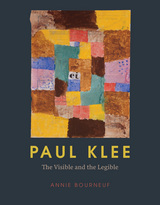 Paul Klee: The Visible and the Legible
Annie Bourneuf
University of Chicago Press, 2015 The fact that Paul Klee (1879–1940) consistently intertwined the visual and the verbal in his art has long fascinated commentators from Walter Benjamin to Michel Foucault. However, the questions it prompts have never been satisfactorily answered—until now. In Paul Klee, Annie Bourneuf offers the first full account of the interplay between the visible and the legible in Klee’s works from the 1910s and 1920s.
Bourneuf argues that Klee joined these elements to invite a manner of viewing that would unfold in time, a process analogous to reading. From his elaborate titles to the small scale he favored to his metaphoric play with materials, Klee created forms that hover between the pictorial and the written. Through his unique approach, he subverted forms of modernist painting that were generally seen to threaten slow, contemplative viewing. Tracing the fraught relations among seeing, reading, and imagining in the early twentieth century, Bourneuf shows how Klee reconceptualized abstraction at a key moment in its development.
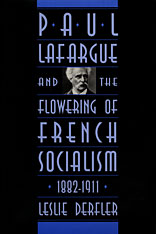 Paul Lafargue and the Flowering of French Socialism, 1882–1911
Leslie Derfler
Harvard University Press, 1998 Paul Lafargue, the disciple and son-in-law of Karl Marx, helped to found the first French Marxist party in 1882. Over the next three decades, he served as the chief theoretician and propagandist for Marxism in France. During these years, which ended with the dramatic suicides of Lafargue and his wife, French socialism, and the Marxist party within it, became a significant political force.
In an earlier volume, Paul Lafargue and the Founding of French Marxism, 1842-1882, Leslie Derfler emphasized family identity and the origin of French Marxism. Here, he explores Lafargue's political strategies, specifically his break with party co-founder Jules Guesde in the Boulanger and Dreyfus episodes and over the question of socialist-syndicalist relations. Derfler shows Lafargue's importance as both political activist and theorist. He describes Lafargue's role in the formulation of such strategies as the promotion of a Second Workingmen's International, the pursuit of reform within the framework of the existent state but opposition to any socialist participation in nonsocialist governments, and the subordination of trade unionism to political action. He emphasizes Lafargue's pioneering efforts to apply Marxist methods of analysis to questions of anthropology, aesthetics, and literary criticism.
Despite the crucial part they played in the social and political changes of the past century and the heritage they left, the first French Marxists are not widely known, especially in the English-speaking world. This important critical biography of Lafargue, the most audacious of their much maligned theorists, enables us to trace the options open to Marxist socialism as well as its development during a critical period of transition.
 Paul Lafargue and the Founding of French Marxism, 1842–1882
Leslie Derfler
Harvard University Press, 1991 Paul Lafargue, disciple and son-in-law of Karl Marx, was among the most important persons giving organized political expression to Marxism in France. He helped found both the first French collectivist party and the first French Marxist party. He was the first Marxist to sit in the French legislature and for three decades served as the chief theoretician and propagandist for Marxism in France. With his wife, Laura, he translated the Communist Manifesto and other works, introducing and applying Marxist thought in France.
Demonstrating an almost seamless web between intellectual and family history, Leslie Derfler relates ideas and family identity in this account of the first forty years of Paul Lafargue’s life. Lafargue, like his famous father-in-law, called for ideological purity and demanded total hostility to anarchists and reformists. He insisted on economic determinism, the primacy of the concept of the class struggle, and the theory of surplus value. But he made his own contributions as well, particularly in his insistence on rejecting the domination of bourgeois values. Lafargue’s most famous pamphlet, The Right To Be Lazy, showed the advantages that labor could derive by rejecting the bourgeois work ethic. An intellectual of power, he pioneered in the application of Marxist methods of analysis to questions of anthropology, aesthetics, and literary criticism.
Born in Cuba of mixed racial descent, Lafargue joined in demonstrations as a medical student in Paris in the 1860s and was forced into exile. Resuming his studies in London, he became a fixture in the Marx household until he married Laura Marx and moved to Paris. There he worked to expand the influence of the International Workingmen’s Association, but fled to Spain following the general repression after the fall of the Paris Commune. He continued his efforts on behalf of Marxism in Spain and then for ten years in London before returning to France, where he helped to found the new Marxist Parti Ouvrier Français, in 1882.
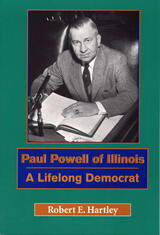 Paul Powell of Illinois: A Lifelong Democrat
Robert E. Hartley
Southern Illinois University Press, 1999 Paul Powell emerged from the hill country of southern Illinois to serve in state government from 1935 until his death in 1970. His political tenure included three terms as Speaker of the Illinois House, four terms as minority leader, and two terms as secretary of state. The sponsor of hundreds of bills, he worked tirelessly for his constituents in southern Illinois. He also worked tirelessly to promote his own interests. In this first political biography of Powell, Robert E. Hartley follows the money. He tells how this man of humble origins and meager means amassed a world-class political and financial base. Part of that story is the disclosure of a personal fortune that boggled minds, including the unbelievable yarn of the $800,000 cash found in the hotel room following Powell's death. Powell never earned a state salary of more than $30,000 per year, yet in the last year of his life, his federal income tax return showed an income of more than $200,000. At his death his estate totaled $3.2 million, and, when settled in 1978, was worth $4.6 million, including nearly $1 million in racetrack stock. Following Powell's story, Hartley takes us deep into the Illinois political world of the 1940s, 1950s, and 1960s, a time when politicians were on an "honor system" regarding their financial holdings. This was before disclosure of political contributions, before computer records, and before public meetings laws.
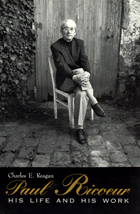 Paul Ricoeur: His Life and His Work
Charles E. Reagan
University of Chicago Press, 1996 One of the major intellectual figures of the twentieth century, Paul Ricoeur has influenced a generation of thinkers. In this, the first philosophically informed biography of Ricoeur, student, colleague, and confidant Charles E. Reagan provides an unusually accessible look at both the philosophy of this extraordinary thinker and the pivotal experiences that influenced his development.
"A valuable introduction to Ricoeur; highly recommended."—Library Journal
"[A] lively introduction to the life and thought of one of this century's most notable philosophers."—Norman Wirzba, Christian Century
"Reagan lucidly explains Ricoeur's difficult philosophy while shining overdue light on the personality behind it."—Carlin Romano, Philadelphia Inquirer
"Combines biographical and philosophical essays with a more personal memoir that makes Ricoeur's humane and magnanimous nature abundantly evident. Four revealing interviews, coupled with photographs, and an extensive bibliography of primary and secondary sources, complete this illuminating study."—Choice
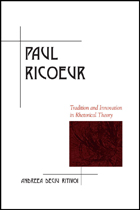 Paul Ricoeur: Tradition and Innovation in Rhetorical Theory
Andreea Deciu Ritivoi
Southern Illinois University Press, 2006 This is the first book to systematically explore contemporary continental philosopher Paul Ricoeur's contribution to modem rhetorical theory. Andreea Deciu Ritivoi analyzes provocative test cases and investigates four topics central to the core vocabulary of the field-opinion, practical reasoning, commemoration, and solidarity. Her findings provide clarification on important problems and shed new light on troubling social and political issues. Placing Ricoeur's views in a larger intellectual context, Ritivoi identifies both the philosophical influences that have shaped them over the years and the correspondences with various relevant rhetorical theories. In doing so, she proves that a rhetorical enterprise refashioned with Ricoeur's help enables us to address questions that are crucially relevant to our time yet also grounded in the historical basis of the discipline.
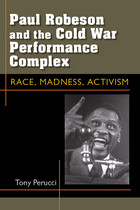 Paul Robeson and the Cold War Performance Complex: Race, Madness, Activism
Tony Perucci
University of Michigan Press, 2012 Actor and singer Paul Robeson's performances in Othello, Show Boat, and The Emperor Jones made him famous, but his midcentury appearances in support of causes ranging from labor and civil rights to antilynching and American warmongering made him notorious. When Robeson announced at the 1949 Paris Peace Conference that it was "unthinkable" for blacks to go to war against the Soviet Union, the mainstream American press declared him insane.
Notions of Communism, blackness, and insanity were interchangeably deployed during the Cold War to discount activism such as Robeson's, just a part of an array of social and cultural practices that author Tony Perucci calls the Cold War performance complex. Focusing on two key Robeson performances---the concerts in Peekskill, New York, in 1949 and his appearance before the House Committee on Un-American Activities in 1956---Perucci demonstrates how these performances and the government's response to them are central to understanding the history of Cold War culture in the United States. His book provides a transformative new perspective on how the struggle over the politics of performance in the 1950s was also a domestic struggle over freedom and equality. The book closely examines both of these performance events as well as artifacts from Cold War culture---including congressional documents, FBI files, foreign policy papers, the popular literature on mental illness, and government propaganda films---to study the operation of power and activism in American Cold War culture.
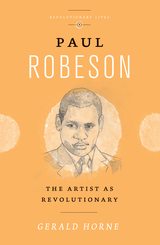 Paul Robeson: The Artist as Revolutionary
Gerald Horne
Pluto Press, 2015 ***Winner PEN Oakland Josephine Miles Book Award***
“A fine, taut analysis of the great African American athlete, singer, actor, and political activist.”
—Choice, Highly Recommended
Paul Robeson should be remembered today as the forerunner of Malcolm X, Dr. Martin Luther King, Jr. and Muhammad Ali. He sacrificed his fame and fortune a performer and athlete in order to fight for the rights of African Americans during the time of Jim Crow and U.S. Apartheid.
A world-famous singer and actor, a trained lawyer, an early star of American professional football and a polyglot who spoke over a dozen languages: these could be the crowning achievements of a life well-lived. Yet for Paul Robeson the higher calling of social justice led him to abandon both the NFL and Hollywood and become one of the most important political activists of his generation, a crusader for freedom and equality who battled both Jim Crow and US Senator Joseph McCarthy during the communist witch hunt of the 1950s.
In Paul Robeson: The Artist as Revolutionary, Gerald Horne discovers within Robeson's remarkable and revolutionary life the story of the twentieth century's great political struggles: against racism, against colonialism, against poverty—and for international socialism. Chapters include:
*”The Best Known American in the World"
*Rising Revolutionary
*From Moscow to Madrid
*"Black Stalin"?
*Robeson: Primary Victim of the "Blacklist"
*Triumph—and Tragedy
*Death of a Revolutionary
In the Introduction, Horne writes: “Paul Robeson—activist, artist, athlete—experienced a dramatic rise and fall, perhaps unparalleled in U.S. history. From mingling with the elite of London society and Hollywood in the 1930s, by the time he died in 1976, he was a virtual recluse in a plain abode in a working-class neighborhood of Philadelphia. What helps to explicate this tragic art of his life is a fateful decision he made when fascism was rising: he threw in his lot with those battling for socialism and decide to sacrifice his thriving artistic career on behalf of the struggle against Jim Crow—or U.S. apartheid.”
This critical and searching biography provides an opportunity for readers to comprehend the triumphs and tragedies of the revolutionary progressive movement of which Paul Robeson was not just a part, but perhaps its most resonant symbol.
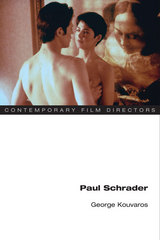 Paul Schrader
George Kouvaros
University of Illinois Press, 2007 As the first full-length study on Paul Schrader's films, this book examines the different styles of his work and the multiple influences on which it draws. A defining feature of Schrader's career is his capacity to engage in a range of collaborations and production contexts while returning to a consistent set of themes, character types, and dramatic scenarios. Going beyond the affirmation of a directorial vision, Schrader creates a cinema driven by issues of obsession, memory, and the difficult nature of experience. Representative of a new generation of American writer-directors of the 1970s, Schrader's films highlight the tension between old and new ways of telling a story and between the maintenance of commercial formulas and openness to individual expression.
George Kouvaros draws on a personal interview conducted with Schrader and the director's prior commentary to trace common motivations and impulses behind such well-known films as Light Sleeper, American Gigolo, Affliction, Auto Focus, Taxi Driver, and Patty Hearst. Kouvaros reads Schrader's films not only in terms of a number of important themes such as male obsession and estrangement, but also in regard to harder to define issues that include melancholia, trauma, and the complex linkages of violence and guilt that bind individuals to places and each other.
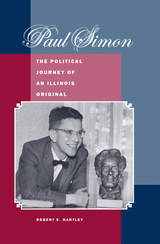 Paul Simon: The Political Journey of an Illinois Original
Robert E. Hartley
Southern Illinois University Press, 2009 With Paul Simon: The Political Journey of an Illinois Original, author Robert E. Hartley presents the first thorough, objective volume on the journalistic and political career of one of Illinois’s most respected public figures. Hartley’s detailed account offers a fully rounded portrait of a man whose ideals and tenacity not only spurred reform on both state and national levels during his celebrated forty-year career but also established the lasting legacy of a political legend. Simon first became a public figure at the age of nineteen, when he assumed the post of editor and publisher of a weekly newspaper in Troy, Illinois. From there, he used his paper to launch a fierce crusade against the crime and corruption plaguing Madison County. This battle sparked his entry into politics, helping to land him a seat in the state legislature in 1954. While serving, he campaigned tirelessly according to his principles, earning him the mass voter approval that would usher him into the seat of lieutenant governor in 1968—the first person elected to that position who did not share party affiliation with the governor. As lieutenant governor, Simon initiated many changes to the position, remaking it to better serve the citizens of the state of Illinois. The cornerstone of his reform plan was an ombudsman program designed to allow the people of the state to voice problems they had with government and state agencies. The program, extremely popular with the public and the press, solved problems and helped to make Simon a household name throughout Illinois. Although he faced challenges along the way, including racial upheaval in Cairo and the student and police riots on the Carbondale campus of Southern Illinois University, Simon’s outspoken honesty and strong support of his constituents earned him the utmost esteem and popularity. While his 1972 bid for governor of Illinois ultimately failed, this did not deter Simon from his dedication to social progress. In 1974 he began his remarkable twenty-two-year career in the U.S. House of Representatives and Senate, where he earned the admiration of the country for his political integrity. Despite the praise and support Simon had earned during his time in Washington, he was unable to win the Democratic presidential nomination in 1988 and returned to the Senate, winning a second term in 1990. Simon committed time and energy to the myriad issues of interest to him, especially in the field of education, with one of his biggest successes coming with the passage of the National Literacy Act, which he sponsored. He continued to foster his ties to journalism throughout his lengthy political career, authoring numerous books, articles, and columns, all of which he used to relentlessly promote open government and social programs. This vivid account of the public life of Paul Simon reveals a man whose personal honor and dedication were unshakeable throughout nearly half a century in the political arena. Robert E. Hartley provides a candid perspective on Simon’s accomplishments and victories, as well as his mistakes and losses, revealing new insights into the life of this dynamic and widely respected public figure.
Paul the Martyr: The Cult of the Apostle in the Latin West
David L. Eastman
SBL Press, 2011 Ancient iconography of Paul is dominated by one image: Paul as martyr. Whether he is carrying a sword—the traditional instrument of his execution—or receiving a martyr's crown from Christ, the apostle was remembered and honored for his faithfulness to the point of death. As a result, Christians created a cult of Paul, centered on particular holy sites and characterized by practices such as the telling of stories, pilgrimage, and the veneration of relics. This study integrates literary, archaeological, artistic, and liturgical evidence to describe the development of the Pauline cult within the cultural context of the late antique West.
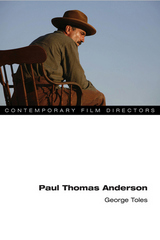 Paul Thomas Anderson
George Toles
University of Illinois Press, 2016 Since his explosive debut with the indie sensation Hard Eight , Paul Thomas Anderson has established himself as one of contemporary cinema's most exciting artists. His 2002 feature Punch-Drunk Love radically reimagined the romantic comedy. Critics hailed There Will Be Blood as a key film of the new millennium. In The Master , Anderson jarred audiences with dreamy amorphousness and a departure from conventional story mechanics. Acclaimed film scholar and screenwriter George Toles approaches these three films in particular, and Anderson's oeuvre in general, with a focus on the role of emergence and the production of the unaccountable. Anderson, Toles shows, is as an artist obsessed with history, workplaces, and environments but also intrigued by spaces as projections of the people who dwell within. Toles follows Anderson from the open narratives of Boogie Nights and Magnolia through the pivot that led to his more recent films, Janus-faced masterpieces that orbit around isolated central characters--and advance Anderson's journey into allegory and myth. Blending penetrative analysis with a deep knowledge of filmic storytelling, Paul Thomas Anderson tours an important filmmaker's ever-deepening landscape of disconnection.
 Paul U. Kellogg and the Survey: Voices for Social Welfare and Social Justice
Clarke A. Chambers
University of Minnesota Press, 1971 Paul U. Kellogg and the Survey was first published in 1971. Minnesota Archive Editions uses digital technology to make long-unavailable books once again accessible, and are published unaltered from the original University of Minnesota Press editions. This joint biography of an editor, Paul U. Kellogg, and a journal, the Survey,provides new insights into the story of social work, social welfare policy, and political and social reform in the United States during the first half of the twentieth century. Under Kellogg's editorship, the Survey and Survey Graphic journals stood at the heart of the evolution of social work as a profession and the development of a public social welfare policy during those years. Early in his career, in 1901, Kellogg joined the staff of the Charities Review,the leading social service publication at that time. In 1912 he became editor in chief of the successor to that journal, the Survey, and he held this position of leadership for forty years until the magazine ceased publication. The journals Kellogg edited played a major role in shaping and defining areas and methods of social service in all its diverse fields — the settlement movement, casework, recreation and group work, community organization, and social action. They carried news in depth about all manner of social work practice—juvenile courts, penology, health, education, institutional care, public relief, the administration of social insurance, and other aspects. The Survey's influence was profound in promoting the elaboration of public policy in social welfare fields, such as housing reform, workmen's compensation, the rights of organized labor, old age and survivors' insurance, unemployment compensation, aid to dependent children, and health insurance. Thus this account represents an important chapter in American social history.
Paul Unbound: Other Perspectives on the Apostle
Mark D. Given
SBL Press, 2022 "As long as there are readers of Paul, there will be always be other perspectives."
The essays in this second edition of Paul Unbound: Other Perspectives on the Apostle provide introductions to Paul's relationship to and views on the Roman Empire, first-century economic stratification, his opponents, ethnicity, the law, Judaism, women, and Greco-Roman rhetoric. Contributors Warren Carter, Charles H. Cosgrove, A. Andrew Das, Steven J. Friesen, Mark D. Given, Deborah Krause, Mark D. Nanos, and Jerry L. Sumney have added addendums to their original essays and updated the bibliography to take into account scholarship produced in the decade since the publication of the first edition. The collection provides essential background and sets out new directions for study useful to students of the New Testament and Paul's letters.
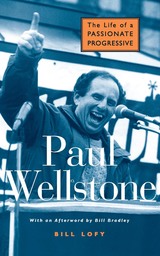 Paul Wellstone: The Life of a Passionate Progressive
Bill Lofy
University of Michigan Press, 2005 "Paul Wellstone, we miss you. Few politicians, especially these days, are as willing to stand up and speak the truth as Wellstone was. In this era of flaccid rhetoric and pre-approved sound bites, he had the rare ability to ignite a fire in his audiences. Bill Lofy's excellent biography rekindles that fire and reminds us just how much politicians of Wellstone's honesty, character, and spine are needed---now more than ever. This book should inspire a new generation of voters and political leaders alike."
---Arianna Huffington, columnist and editor of HuffingtonPost.com
"This book captures the vibrant spirit of my friend Paul Wellstone---the fierce commitment to justice that defined his life, and that shapes his enduring legacy."
---U.S. Senator Russ Feingold
"Paul Wellstone was a great leader because he fused progressive idealism with a stubbornly pragmatic politics. Bill Lofy's book captures that dual commitment in his story of Wellstone's life, and also shows us the extraordinary human appeal that Wellstone emanated in his relationships with people in all walks of life. This book is an engaging read that also tells us a lot about the political practice to which we should aspire."
---Frances Fox Piven, author of The War at Home
"This vividly written book captures the life and personal qualities of the late Senator Paul Wellstone. In so doing it provides an illuminating gloss on Max Weber's seminal exposition of the political vocation. It is a jewel of a book."
-Fred Greenstein, Princeton University
Bill Lofy's fast-paced and readable biography tells the inspirational story of one of the most compelling figures in the history of American politics---Senator Paul Wellstone.
Yet Lofy's book is more than just the chronicle of Wellstone's life and political career; it's also an indispensable guide to what ails political life today. Readers politically inclined or not will find in its pages a handbook to the uncertain and often treacherous business of politics and a stirring example for living a courageous and honest life---whether as public servant or private individual.
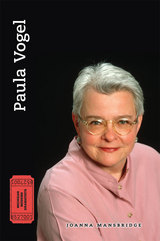 Paula Vogel
Joanna Mansbridge
University of Michigan Press, 2014 Paula Vogel’s plays, including the Pulitzer–prizewinning How I Learned to Drive, initiate a conversation with contemporary culture, staging vexed issues like domestic violence, pornography, and AIDS. She does not write "about" these concerns, but instead examines how they have become framed as “issues”–as sensationalized topics–focusing on the histories and discourses that have defined them and the bodies that bear their meanings. Mobilizing campy humor, keen insight, and nonlinear structure, her plays defamiliarize the identities and issues that have been fixed as "just the way things are." Vogel crafts collage-like playworlds that are comprised of fragments of history and culture, and that are simultaneously inclusive and alienating, familiar and strange, funny and disturbing. At the center of these playworlds are female characters negotiating with the images and discourses that circumscribe their lives and bodies. In this, the first book-length study of Vogel and her work, Joanna Mansbridge explores how Vogel’s plays speak back to the canon, responding to and rewriting works by William Shakespeare, Edward Albee, Sam Shepard, and David Mamet, rearranging their plots, revising their conflicts, and recasting their dramatis personae. The book examines the theories shaping the playwright and her plays, the production and reception of her work, and the aesthetic structure of each play, grounding the work in cultural materialist, feminist and queer theory, and theater and performance studies scholarship.
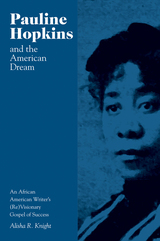 Pauline Hopkins and the American Dream: An African American Writer's (Re)Visionary Gospel of Success
Alisha Knight
University of Tennessee Press, 2012
Pauline Elizabeth Hopkins was perhaps the most prolific black female writer of her time. Between 1900 and 1904, writing mainly for Colored American Magazine, she published four novels, at least seven short stories, and numerous articles that often addressed the injustices and challenges facing African Americans in post–Civil War America. In Pauline Hopkins and the American Dream, Alisha Knight provides the first full-length critical analysis of Hopkins’s work.
Scholars have frequently situated Hopkins within the domestic, sentimental tradition of nineteenth-century women's writing, with some critics observing that aspects of her writing, particularly its emphasis on the self-made man, seem out of place within the domestic tradition. Knight argues that Hopkins used this often-dismissed theme to critique American society's ingrained racism and sexism. In her “Famous Men” and “Famous Women” series for Colored American Magazine, she constructed her own version of the success narrative by offering models of African American self-made men and women. Meanwhile, in her fiction, she depicted heroes who fail to achieve success or must leave the United States to do so.
Hopkins risked and eventually lost her position at Colored American Magazine by challenging black male leaders, liberal white philanthropists, and white racists—and by conceiving a revolutionary treatment of the American Dream that placed her far ahead of her time. Hopkins is finally getting her due, and this clear-eyed analysis of her work will be a revelation to literary scholars, historians of African American history, and students of women’s studies.
Alisha Knight is an associate professor of English and American Studies at Washington College. Her published articles include “Furnace Blasts for the Tuskegee Wizard: Revisiting Pauline E. Hopkins, Booker T. Washington, and the Colored American Magazine,” which appeared in American Periodicals.
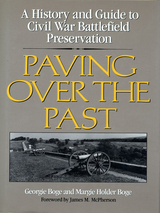 Paving Over the Past: A History And Guide To Civil War Battlefield Preservation
Georgie Boge and Margie Boge; Foreword by James M. McPherson
Island Press, 1993 In this exhaustively researched book, Georgie Boge and Margie Boge analyze the issues and controversies surrounding the preservation of Civil War battlefield sites, and offer a pragmatic development program designed to accommodate the needs of both historic preservation and economic growth. Not only do they provide a framework for developing actual preservation strategies, they show how important historical, cultural, and natural resources can be preserved with economic benefit to the community. After exploring the special importance of battlefield sites to the nation, the Boges discuss existing policies for preservation. Through extensive case studies, they demonstrate the inadequacies of current mechanisms, and present a detailed policy program that could effectively protect the remaining land, and also help save other historically or culturally significant sites.
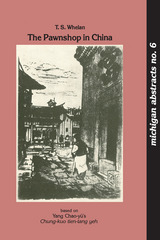 The Pawnshop in China
Yang Chao-yu; Translated by T. S. Whelan
University of Michigan Press, 1979 The Ch’ing dynasty witnessed a phenomenal rise in the number of pawnshops in China. By the early nineteenth century there were almost 25,000 of them, and pawnbroking yielded a higher rate of return on investment than did land. The Ch’ing also saw this industry in decline, its exponential growth a victim of the Taiping Rebellion and rapidly developing Shansi banks. Yet, in republican times the pawnshop was still common in city and countryside alike. Furthermore, it was to live on after Liberation. But when the People’s Bank of China opened Citizens’ Petty Loan Offices in the early 1950s in order to furnish workers and peasant with low-interest loans, and when the transformation of private enterprise occurred in 1956, the last of the pawnbrokers, holding out in urban areas such as Shanghai, were forced to close their doors, and the pawnshop ceased to exist on the mainland. Its life had spanned almost fifteen hundred years. On Taiwan, however, the institution survives—there were 750 pawnshops on the island in 1974—as it does in most overseas Chinese communities. This volume is a translation of Yang’s Chung-kuo tien-tang yeh, which examines pawnshops during late imperial and Republican China. T. S. Whelan provides a historical introduction and critical annotations.
Pax Americana
Paul Otremba
Four Way Books, 2015 The poems in Pax Americana are born out of the violent, fractious, and disillusioning opening to the 21st century. The decade of protracted wars and economic collapse—coupled with the polarizing of wealth and ideologies in this country—create the catalysts for this book. These are social poems that want to talk, and through talking hopefully make a space where people can meet and find meaning in each other.
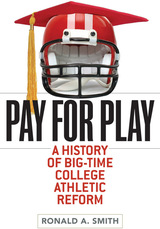 Pay for Play: A History of Big-Time College Athletic Reform
Ronald A. Smith
University of Illinois Press, 2011 In an era when college football coaches frequently command higher salaries than university presidents, many call for reform to restore the balance between amateur athletics and the educational mission of schools. This book traces attempts at college athletics reform from 1855 through the early twenty-first century while analyzing the different roles played by students, faculty, conferences, university presidents, the NCAA, legislatures, and the Supreme Court. Pay for Play: A History of Big-Time College Athletic Reform also tackles critically important questions about eligibility, compensation, recruiting, sponsorship, and rules enforcement. Discussing reasons for reform--to combat corruption, to level the playing field, and to make sports more accessible to minorities and women--Ronald A. Smith candidly explains why attempts at change have often failed. Of interest to historians, athletic reformers, college administrators, NCAA officials, and sports journalists, this thoughtful book considers the difficulty in balancing the principles of amateurism with the need to draw income from sporting events.
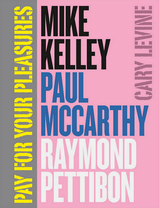 Pay for Your Pleasures: Mike Kelley, Paul McCarthy, Raymond Pettibon
Cary Levine
University of Chicago Press, 2013 Mike Kelley, Paul McCarthy, and Raymond Pettibon—these Southern California artists formed a “bad boy” trifecta. Early purveyors of abject art, the trio produced work ranging from sculptures of feces to copulating stuffed animals, and gained notoriety from being perverse. Showing how their work rethinks transgressive art practices in the wake of the 1960s, Pay for Your Pleasures argues that their collaborations as well as their individual enterprises make them among the most compelling artists in the Los Angeles area in recent years. Cary Levine focuses on Kelley’s, McCarthy’s, and Pettibon’s work from the 1970s through the 1990s, plotting the circuitous routes they took in their artistic development. Drawing on extensive interviews with each artist, he identifies the diverse forces that had a crucial bearing on their development—such as McCarthy’s experiences at the University of Utah, Kelley’s interest in the Detroit-based White Panther movement, Pettibon’s study of economics, and how all three participated in burgeoning subcultural music scenes. Levine discovers a common political strategy underlying their art that critiques both nostalgia for the 1960s counterculture and Reagan-era conservatism. He shows how this strategy led each artist to create strange and unseemly images that test the limits of not only art but also gender roles, sex, acceptable behavior, poor taste, and even the gag reflex that separates pleasure from disgust. As a result, their work places viewers in uncomfortable situations that challenge them to reassess their own values. The first substantial analysis of Kelley, McCarthy, and Pettibon, Pay for Your Pleasures shines new light on three artists whose work continues to resonate in the world of art and politics.
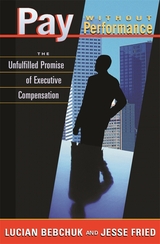 Pay without Performance: The Unfulfilled Promise of Executive Compensation
Lucian Bebchuk and Jesse Fried
Harvard University Press, 2006 The company is under-performing, its share price is trailing, and the CEO gets...a multi-million-dollar raise. This story is familiar, for good reason: as this book clearly demonstrates, structural flaws in corporate governance have produced widespread distortions in executive pay. Pay without Performance presents a disconcerting portrait of managers' influence over their own pay--and of a governance system that must fundamentally change if firms are to be managed in the interest of shareholders.
Lucian Bebchuk and Jesse Fried demonstrate that corporate boards have persistently failed to negotiate at arm's length with the executives they are meant to oversee. They give a richly detailed account of how pay practices--from option plans to retirement benefits--have decoupled compensation from performance and have camouflaged both the amount and performance-insensitivity of pay. Executives' unwonted influence over their compensation has hurt shareholders by increasing pay levels and, even more importantly, by leading to practices that dilute and distort managers' incentives.
This book identifies basic problems with our current reliance on boards as guardians of shareholder interests. And the solution, the authors argue, is not merely to make these boards more independent of executives as recent reforms attempt to do. Rather, boards should also be made more dependent on shareholders by eliminating the arrangements that entrench directors and insulate them from their shareholders. A powerful critique of executive compensation and corporate governance, Pay without Performance points the way to restoring corporate integrity and improving corporate performance.
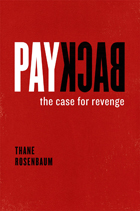 Payback: The Case for Revenge
Thane Rosenbaum
University of Chicago Press, 2013 We call it justice—the assassination of Osama bin Laden, the incarceration of corrupt politicians or financiers like Rod Blagojevich and Bernard Madoff, and the climactic slaying of cinema-screen villains by superheroes. But could we not also call it revenge? We are told that revenge is uncivilized and immoral, an impulse that individuals and societies should actively repress and replace with the order and codes of courtroom justice. What, if anything, distinguishes punishment at the hands of the government from a victim’s individual desire for retribution? Are vengeance and justice really so very different? No, answers legal scholar and novelist Thane Rosenbaum in Payback: The Case for Revenge—revenge is, in fact, indistinguishable from justice. Revenge, Rosenbaum argues, is not the problem. It is, in fact, a perfectly healthy emotion. Instead, the problem is the inadequacy of lawful outlets through which to express it. He mounts a case for legal systems to punish the guilty commensurate with their crimes as part of a societal moral duty to satisfy the needs of victims to feel avenged. Indeed, the legal system would better serve the public if it gave victims the sense that vengeance was being done on their behalf. Drawing on a wide range of support, from recent studies in behavioral psychology and neuroeconomics, to stories of vengeance and justice denied, to revenge practices from around the world, to the way in which revenge tales have permeated popular culture—including Hamlet, The Godfather, and Braveheart—Rosenbaum demonstrates that vengeance needs to be more openly and honestly discussed and lawfully practiced.
Fiercely argued and highly engaging, Payback is a provocative and eye-opening cultural tour of revenge and its rewards—from Shakespeare to The Sopranos. It liberates revenge from its social stigma and proves that vengeance is indeed ours, a perfectly human and acceptable response to moral injury. Rosenbaum deftly persuades us to reconsider a misunderstood subject and, along the way, reinvigorates the debate on the shape of justice in the modern world.
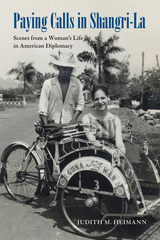 Paying Calls in Shangri-La: Scenes from a Woman’s Life in American Diplomacy
Judith M. Heimann
Ohio University Press, 2016 Judith M. Heimann entered the diplomatic life in 1958 to join her husband, John, in Jakarta, Indonesia, at his American Embassy post. This, her first time out of the United States, would set her on a path across the continents as she mastered the fine points of diplomatic culture. She did so first as a spouse, then as a diplomat herself, thus becoming part of one of the Foreign Service’s first tandem couples. Heimann’s lively recollections of her life in Africa, Asia, and Europe show us that when it comes to reconciling our government’s requirements with the other government’s wants, shuttle diplomacy, Skype, and email cannot match on-the-ground interaction. The ability to gauge and finesse gesture, tone of voice, and unspoken assumptions became her stock-in-trade as she navigated, time and again, remarkably delicate situations. This insightful and witty memoir gives us a behind-the-scenes look at a rarely explored experience: that of one of the very first married female diplomats, who played an unsung but significant role in some of the important international events of the past fifty years. To those who know something of today’s world of diplomacy, Paying Calls in Shangri-La will be an enlightening tour through the way it used to be—and for aspiring Foreign Service officers and students, it will be an inspiration. Published in association with ADST-DACOR Diplomats and Diplomacy Series
 Paying for the Party: How College Maintains Inequality
Elizabeth A. Armstrong and Laura T. Hamilton
Harvard University Press, 2013 Two young women, dormitory mates, embark on their education at a big state university. Five years later, one is earning a good salary at a prestigious accounting firm. With no loans to repay, she lives in a fashionable apartment with her fiancé. The other woman, saddled with burdensome debt and a low GPA, is still struggling to finish her degree in tourism. In an era of skyrocketing tuition and mounting concern over whether college is "worth it," Paying for the Party is an indispensable contribution to the dialogue assessing the state of American higher education. A powerful exposé of unmet obligations and misplaced priorities, it explains in vivid detail why so many leave college with so little to show for it.
Drawing on findings from a five-year interview study, Elizabeth Armstrong and Laura Hamilton bring us to the campus of "MU," a flagship Midwestern public university, where we follow a group of women drawn into a culture of status seeking and sororities. Mapping different pathways available to MU students, the authors demonstrate that the most well-resourced and seductive route is a "party pathway" anchored in the Greek system and facilitated by the administration. This pathway exerts influence over the academic and social experiences of all students, and while it benefits the affluent and well-connected, Armstrong and Hamilton make clear how it seriously disadvantages the majority.
Eye-opening and provocative, Paying for the Party reveals how outcomes can differ so dramatically for those whom universities enroll.
 Paying for the Party: How Fundraising Demands Lead to Less Productive and Less Representative Legislatures
Michael Kistner
University of Chicago Press A revealing, data-rich exploration of how American legislators transformed from active policymakers into party fundraisers. Lawmakers in Congress and state legislatures across the United States spend enormous amounts of time and effort fundraising, not just for their own seats but for the party. Whether dialing for dollars or hosting high-priced fundraising events, the pursuit of campaign funds is now a massive part of the American legislator’s job description. What explains this transformation, and what are the consequences for public policy? In Paying for the Party, Michael Kistner uses new theory and new data to answer these questions. He shows that state legislative party organizations—Democratic and Republican caucuses in capitols across the country—are responsible for turning their members into single-minded seekers of money. Parties reward legislators who contribute the most with powerful leadership and committee positions. Consequently, the members who now hold these agenda-setting positions are increasingly neither the most productive nor knowledgeable lawmakers, but rather those who can raise the most money. And when legislators are asked to raise more money, they skip committee hearings for fundraising events, enacting fewer substantive policies as a result. Paying for the Party shows that parties in contemporary American legislatures have hollowed out the policymaking capacity of their institutions and empowered a decidedly non-representative set of legislators.
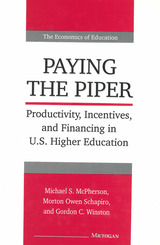 Paying the Piper: Productivity, Incentives, and Financing in U.S. Higher Education
Michael S. McPherson, Morton Owen Schapiro, and Gordon C. Winston, Editors
University of Michigan Press, 1994 Rising tuitions and shrinking government budgets have pushed questions about productivity and resource use in U.S. higher education to the fore. In Paying the Piper three distinguished researchers examine the many successes of U.S. higher education, identify real problems, and carefully analyze potential solutions. Among the questions addressed are: On what do colleges and universities spend their money and how have their spending patterns changed over time; what does "quality" really mean in higher education and how is it related to price and cost; what are appropriate measures of "productivity"; and does increasing the amount of federal financial aid encourage colleges to raise their tuitions? The essays comprising this volume demonstrate that the application of basic economic principles and a combination of both descriptive and econometric analyses can illuminate a number of issues. Using economic concepts and tools to provide insight into these pressing questions, Paying the Piper helps us to understand the recent past, anticipate the future, and develop policies that can influence the future.
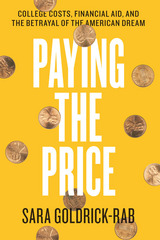 Paying the Price: College Costs, Financial Aid, and the Betrayal of the American Dream
Sara Goldrick-Rab
University of Chicago Press, 2016 If you are a young person, and you work hard enough, you can get a college degree and set yourself on the path to a good life, right?
Not necessarily, says Sara Goldrick-Rab, and with Paying the Price, she shows in damning detail exactly why. Quite simply, college is far too expensive for many people today, and the confusing mix of federal, state, institutional, and private financial aid leaves countless students without the resources they need to pay for it.
Drawing on an unprecedented study of 3,000 young adults who entered public colleges and universities in Wisconsin in 2008 with the support of federal aid and Pell Grants, Goldrick-Rab reveals the devastating effect of these shortfalls. Half the students in the study left college without a degree, while less than 20 percent finished within five years. The cause of their problems, time and again, was lack of money. Unable to afford tuition, books, and living expenses, they worked too many hours at outside jobs, dropped classes, took time off to save money, and even went without adequate food or housing. In many heartbreaking cases, they simply left school—not with a degree, but with crippling debt. Goldrick-Rab combines that shocking data with devastating stories of six individual students, whose struggles make clear the horrifying human and financial costs of our convoluted financial aid policies.
America can fix this problem. In the final section of the book, Goldrick-Rab offers a range of possible solutions, from technical improvements to the financial aid application process, to a bold, public sector–focused “first degree free” program. What’s not an option, this powerful book shows, is doing nothing, and continuing to crush the college dreams of a generation of young people.
 Paying the Price: Ignacio Ellacuría and the Murdered Jesuits of El Salvador
Teresa Whitfield
Temple University Press, 1994 On November 16, 1989, on the campus of El Salvador's University of Central America, six Jesuits and two women were murdered by members of the Salvadoran army, an army funded and trained by the United States. One of the murdered Jesuits was Ignacio Ellacuría, the university's Rector and a key, although controversial, figure in Salvadoran public life. From an opening account of this terrible crime, Paying the Price asks, Why were they killed and what have their deaths meant? Answers come through Teresa Whitfield's detailed examination of Ellacuría's life and work. His story is told in juxtaposition with the crucial role played by the unraveling investigation of the Jesuits' murders within El Salvador's peace process. A complex and nuanced book, Paying the Price offers a history of the Church in El Salvador in recent decades, an analysis of Ellacuría's philosophy and theology, an introduction to liberation theology, and an account of the critical importance of the University of Central America. In the end, Whitfield's comprehensive picture of conditions in El Salvador suggest that the Jesuits' murders were almost inevitable. A crime that proved a turning point in El Salvador's civil war, the murders expressed the deep tragedy of the Salvadoran people beyond suffering the heartless cruelty, violence, and deceitfulness of a corrupt military and their patrons in the U.S. government. Whitfield draws on her extensive research of Jesuit archives and private papers, Ellacuría's diaries, documents declassified by the U.S. government, and 200 interviews conducted with sources ranging from Jesuits to Salvadoran military officers, U.S. officials and congressmen to human rights campaigners.
Paying the Words Extra: Religious Discourse in the Supreme Court of the United States
Winnifred Fallers Sullivan
Harvard University Press, 1994 In 1985 the Supreme Court ruled in Lynch v. Donnelly that the inclusion of a life-sized crèche in a civic Christmas display did not constitute an unconstitutional establishment of religion. Through her examination of this difficult case, Sullivan reveals divergent American understandings of the nature of religion, the role of religion in public life, and the relationship and interaction of law and religion.
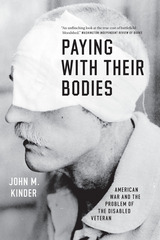 Paying with Their Bodies: American War and the Problem of the Disabled Veteran
John M. Kinder
University of Chicago Press, 2015 Christian Bagge, an Iraq War veteran, lost both his legs in a roadside bomb attack on his Humvee in 2006. Months after the accident, outfitted with sleek new prosthetic legs, he jogged alongside President Bush for a photo op at the White House. The photograph served many functions, one of them being to revive faith in an American martial ideal—that war could be fought without permanent casualties, and that innovative technology could easily repair war’s damage. When Bagge was awarded his Purple Heart, however, military officials asked him to wear pants to the ceremony, saying that photos of the event should be “soft on the eyes.” Defiant, Bagge wore shorts.
America has grappled with the questions posed by injured veterans since its founding, and with particular force since the early twentieth century: What are the nation’s obligations to those who fight in its name? And when does war’s legacy of disability outweigh the nation’s interests at home and abroad? In Paying with Their Bodies, John M. Kinder traces the complicated, intertwined histories of war and disability in modern America. Focusing in particular on the decades surrounding World War I, he argues that disabled veterans have long been at the center of two competing visions of American war: one that highlights the relative safety of US military intervention overseas; the other indelibly associating American war with injury, mutilation, and suffering. Kinder brings disabled veterans to the center of the American war story and shows that when we do so, the history of American war over the last century begins to look very different. War can no longer be seen as a discrete experience, easily left behind; rather, its human legacies are felt for decades.
The first book to examine the history of American warfare through the lens of its troubled legacy of injury and disability, Paying with Their Bodies will force us to think anew about war and its painful costs.
 Payne Hollow: Life on the Fringe of Society
Harlan Hubbard
Ohio University Press, 1997 Originally published in 1974, this second edition was published by Gnomon Press in 1997.Payne Hollow is a reflective and poetic memoir that details the simple, self-sufficient life Harlan Hubbard and his wife, Anna, led along the banks of the Ohio River in the 1950s–80s. After living on a shantyboat for eight years, the Hubbards crafted a custom home and studio at Payne Hollow, in Trimble County, Kentucky, where they lived off the land and embraced a lifestyle focused on nature, art, and solitude. The book, illustrated with Harlan’s own ink drawings, captures the couple’s philosophy of living in harmony with the natural world, free from the distractions and demands of modern society. Hubbard eloquently describes in words and images their daily routines, the changing seasons, and the deep satisfaction he and Anna found in their way of life. Through his writing, Hubbard rejoices in the return to simplicity and creates an appreciation for the living world, making Payne Hollow not just a memoir, but a model for building a deliberate, mindful life in tune with nature.
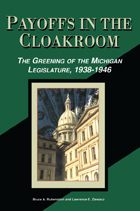 Payoffs in the Cloakroom: The Greening of the Michigan Legislature, 1938-1946
Bruce A. Rubenstein
Michigan State University Press, 1995 Payoffs in the Cloakroom is a spellbinding follow-up to Rubenstein and Ziewacz's critically acclaimed Three Bullets Sealed His Lips. Three Bullets brought to life new evidence on the 1945 murder of Michigan Senator Warren Hooper. Payoffs in the Cloakroom takes up where Three Bullets left off, unraveling a complex web of political corruption and dirty state politics. In the process, the authors demonstrate that Senator Hooper was murdered to prevent his grand jury testimony against republican boss Frank McKay, who was facing bribery charges.
Making use of actual court proceeding, personal interviews, and newspaper accounts, and even a re-evaluation of police evidence, Rubenstein and Ziewacz tell a story that contains all the ingredients of first-class detective fiction—only in this instance, the story is based on fact. With chapter titles such as "Charlie and His Little Black Book," "I Never Dreamed Murder," and "Them Bones, Them Bones," the authors have, once again, provided a stimulating and absorbing account of one of the darker chapters of Michigan's political history.
PBZ vol 86 num 1
The University of Chicago Press
University of Chicago Press Journals, 2013
PBZ vol 86 num 2
The University of Chicago Press
University of Chicago Press Journals, 2013
PBZ vol 86 num 3
The University of Chicago Press
University of Chicago Press Journals, 2013
PBZ vol 86 num 4
The University of Chicago Press
University of Chicago Press Journals, 2013
PBZ vol 86 num 5
The University of Chicago Press
University of Chicago Press Journals, 2013
PBZ vol 86 num 6
The University of Chicago Press
University of Chicago Press Journals, 2013
PBZ vol 87 num 1
The University of Chicago Press
University of Chicago Press Journals, 2014
PBZ vol 87 num 2
The University of Chicago Press
University of Chicago Press Journals, 2014
PBZ vol 87 num 3
The University of Chicago Press
University of Chicago Press Journals, 2014
PBZ vol 87 num 4
The University of Chicago Press
University of Chicago Press Journals, 2014
PBZ vol 87 num 5
The University of Chicago Press
University of Chicago Press Journals, 2014
PBZ vol 87 num 6
The University of Chicago Press
University of Chicago Press Journals, 2014
PBZ vol 88 num 1
The University of Chicago Press
University of Chicago Press Journals, 2015
PBZ vol 88 num 2
The University of Chicago Press
University of Chicago Press Journals, 2015
PBZ vol 88 num 3
The University of Chicago Press
University of Chicago Press Journals, 2015
PBZ vol 88 num 4
The University of Chicago Press
University of Chicago Press Journals, 2015
PBZ vol 88 num 5
The University of Chicago Press
University of Chicago Press Journals, 2015
PBZ vol 88 num 6
The University of Chicago Press
University of Chicago Press Journals, 2015
PBZ vol 89 num 1
The University of Chicago Press
University of Chicago Press Journals, 2016
PBZ vol 89 num 2
The University of Chicago Press
University of Chicago Press Journals, 2016
PBZ vol 89 num 3
The University of Chicago Press
University of Chicago Press Journals, 2016
PBZ vol 89 num 4
The University of Chicago Press
University of Chicago Press Journals, 2016
PBZ vol 89 num 5
The University of Chicago Press
University of Chicago Press Journals, 2016
PBZ vol 89 num 6
The University of Chicago Press
University of Chicago Press Journals, 2016
PBZ vol 90 num 1
The University of Chicago Press
University of Chicago Press Journals, 2017
PBZ vol 90 num 2
The University of Chicago Press
University of Chicago Press Journals, 2017
PBZ vol 90 num 3
The University of Chicago Press
University of Chicago Press Journals, 2017
PBZ vol 90 num 4
The University of Chicago Press
University of Chicago Press Journals, 2017
PBZ vol 90 num 5
The University of Chicago Press
University of Chicago Press Journals, 2017
PBZ vol 90 num 6
The University of Chicago Press
University of Chicago Press Journals, 2017
PBZ vol 91 num 1
The University of Chicago Press
University of Chicago Press Journals, 2018
PBZ vol 91 num 2
The University of Chicago Press
University of Chicago Press Journals, 2018
PBZ vol 91 num 3
The University of Chicago Press
University of Chicago Press Journals, 2018
PBZ vol 91 num 4
The University of Chicago Press
University of Chicago Press Journals, 2018
PBZ vol 91 num 5
The University of Chicago Press
University of Chicago Press Journals, 2018
PBZ vol 91 num 6
The University of Chicago Press
University of Chicago Press Journals, 2018
PBZ vol 92 num 1
The University of Chicago Press
University of Chicago Press Journals, 2019
PBZ vol 92 num 2
The University of Chicago Press
University of Chicago Press Journals, 2019
PBZ vol 92 num 3
The University of Chicago Press
University of Chicago Press Journals, 2019
PBZ vol 92 num 4
The University of Chicago Press
University of Chicago Press Journals, 2019
PBZ vol 92 num 5
The University of Chicago Press
University of Chicago Press Journals, 2019
PBZ vol 92 num 6
The University of Chicago Press
University of Chicago Press Journals, 2019
PBZ vol 93 num 1
The University of Chicago Press
University of Chicago Press Journals, 2020
PBZ vol 93 num 2
The University of Chicago Press
University of Chicago Press Journals, 2020
PBZ vol 93 num 3
The University of Chicago Press
University of Chicago Press Journals, 2020
PBZ vol 93 num 4
The University of Chicago Press
University of Chicago Press Journals, 2020
PBZ vol 93 num 5
The University of Chicago Press
University of Chicago Press Journals, 2020
PBZ vol 93 num 6
The University of Chicago Press
University of Chicago Press Journals, 2020
PBZ vol 94 num 1
The University of Chicago Press
University of Chicago Press Journals, 2021
PBZ vol 94 num 2
The University of Chicago Press
University of Chicago Press Journals, 2021
 PCBs: Human and Environmental Disposition and Toxicology
Edited by Larry G. Hansen and Larry W. Robertson
University of Illinois Press, 2007 Though polychlorinated biphenyls (PCBs) have been banned in the United States for more than thirty years, the toxic effects of their presence in local environments continue to be a significant public health concern. PCBs: Human and Environmental Disposition and Toxicology brings together more than fifty established specialists on PCB toxicity to discuss recent trends and specialized investigations of PCB influences on the environment and on humans. Renowned scientists including Paul S. Cooke, Takeshi Nakano, Tomas Trnovec, Deborah C. Rice, Linda S. Birnbaum, and Charles S. Wong present cutting-edge research on Hudson River PCBs, human contamination, homologue profiles, high PCB exposure in Slovakia, and PCB effects on the thyroid hormone, nutrition, and estrogen levels in humans and animals. Focusing on the detection, movement, metabolism, toxicity, remediation, and risk assessment of PCB contamination, this multi-disciplinary study is a valuable resource for regulatory agencies and scientists working with PCBs.
PCE 1604 Series, Frigate Panter
Henk Visser
Amsterdam University Press, 2023 The six Frigate Panters were all built in the USA with MDAP funds. They were designed to escort slow coastal convoys in the Channel and North Sea areas and were operated as a single squadron by the Royal Netherlands Navy. They proved useful in a number of peacetime tasks, especially fishery protection, and some retained this role in the North Sea until the mid-1980s.
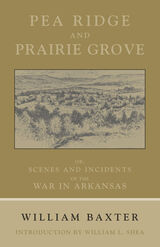 Pea Ridge and Prairie Grove: Scenes and Incidents fo the War in Arkansas
William Baxter
University of Arkansas Press, 2000 With the goal of sketching “at least some of the bright lights and dark shadows of the war;” William Baxter authored his regional classic, Pea Ridge and Prairie Grove, in 1864, before the actual end of the Civil War. Primarily focusing on the civilians of the region, Baxter vividly describes their precarious and vulnerable positions during the advances and retreats of armies as Confederate and Federal forces marched across their homeland. In his account, Baxter describes skirmishes and cavalry charges outside his front door, the “firing” of his town’s buildings during a Confederate retreat, clashes between secessionist and Unionist neighbors, the feeding of hungry soldiers and the forceful appropriation of his remaining food supply, and the sickening sight of the wounded emerging from the Prairie Grove battlefield. Since its original printing, this firsthand account has only been reprinted once, in 1957, and both editions are considered collectors’ items today. Of interest to Civil War scholars and general readers alike, Baxter’s compelling social history is rendered even more comprehensive by William Shea’s introduction. Pea Ridge and Prairie Grove is a valuable personal account of the Civil War in the Trans-Mississippi West which enables us to better comprehend the conflict as a whole and its devastating effect on the general populace of the war-torn portions of the country.
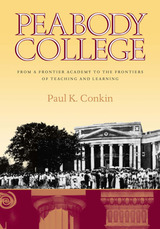 Peabody College: From a Frontier Academy to the Frontiers of Teaching and Learning
Paul K. Conkin
Vanderbilt University Press, 2002 Today George Peabody College is a part of Vanderbilt University, as it has been since its merger in 1979. Its prior history was rich and complex. In this book, Paul Conkin, author of the award-winning history of Vanderbilt, Gone with the Ivy, tells the story of Peabody's many lives, of its successes and failures, and of its many colorful leaders and professors.
It all began as a small frontier academy in 1785. The institution that would become Peabody experienced its first reinvention two decades later as it became Cumberland College, and then, in 1826, the University of Nashville. The University maintained an elite undergraduate college until 1850, and, despite the success of its medical school and a military institute, it failed in three subsequent efforts to restart its undergraduate program.
In 1875 the University offered its campus and degree-granting authority to the first normal school in the state of Tennessee, a school funded by the Peabody Education Fund. The Peabody Normal College was the best in the South, and, as such, exerted an enormous influence on education in the region.
A new era began in 1909. The trustees of the Peabody Fund, at its liquidation, provided an eventual $1.5 million to establish a graduate-level George Peabody College for Teachers. It opened for classes in 1914, on its present campus, where it quickly became the premier teachers' college in the South. As was the case with many private, independent institutions, Peabody faced intermittent financial struggles, which finally ended with its union with Vanderbilt. Today Peabody is, by almost any criteria, one of the five or six strongest colleges of education in the United States.
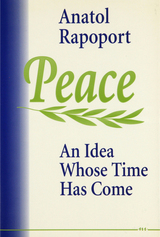 Peace
Anatol Rapoport
University of Michigan Press, 1992 In Peace: An Idea Whose Time Has Come, noted mathematician and peace researcher Anatol Rapoport explores the evolution of the idea of peace and explains why it is displacing war as a viable institution. Professor Rapoport ventures into uncharted philosophical territory by drawing on both the natural and the social sciences to trace the development of the ideas of war and peace. He argues that the theory of evolution and processes analogous to natural selection can explain not only biological events, but also the development of the institution of war. Thus the clashes of armed hordes at the dawn of history were the “ancestors” of our present battles using automated weapons, while Isaiah’s prophecy of total disarmament—“And they shall beat their swords into ploughshares”—anticipates the resolutions of the United Nations. Rapoport explains that although the institution of war enjoys a long history and continues to be a policy option today, it may soon fall into disuse, either by losing its relevance to modern life or by destroying the civilizations that practice it. He then calls attention to ideas that lie dormant until people’s “ideational environment” becomes receptive to their germination: peace, Anatol Rapoport believes, is one such idea. Peace continues in the interdisciplinary tradition that has taken root in inquiries at the nexus of science and philosophy. No specific technical knowledge is expected of the reader, only a willingness to venture into little-charted areas of thought.
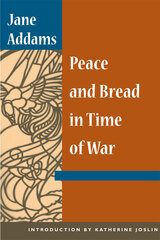 Peace and Bread in Time of War
Jane Addams
University of Illinois Press, 2002 First published in 1922 during the "Red Scare," by which time Jane Addams's pacifist efforts had adversely affected her popularity as an author and social reformer, Peace and Bread in Time of War is Addams's eighth book and the third to deal with her thoughts on pacifism.
Addams's unyielding pacifism during the Great War drew criticism from politicians and patriots who deemed her the "most dangerous woman in America." Even those who had embraced her ideals of social reform condemned her outspoken opposition to U.S. entry into World War I or were ambivalent about her peace platforms. Turning away from the details of the war itself, Addams relies on memory and introspection in this autobiographical portrayal of efforts to secure peace during the Great War. "I found myself so increasingly reluctant to interpret the motives of other people that at length I confined all analysis of motives to my own," she writes. Using the narrative technique she described in The Long Road of Women's Memory, an extended musing on the roles of memory and myth in women's lives, Addams also recalls attacks by the press and defends her political ideals.
Katherine Joslin's introduction provides additional historical context to Addams's involvement with the Woman's Peace Party, the Women's International League for Peace and Freedom, and her work on Herbert Hoover's campaign to provide relief and food to women and children in war-torn enemy countries.
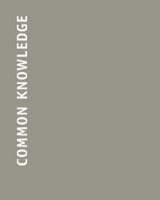 Peace and Mind: Part 3: Seriatim Symposium on Dispute, Conflict, and Enmity, Volume 8
Jeffrey M. Perl, ed.
Duke University Press Scholars must make their names, assert themselves, take credit for their original work, and stake claims to their positions to achieve credibility in their disciplines. Common Knowledge is dedicated to a mission that is often at odds with this academic protocol. The journal aims to break down boundaries between disciplines, find compromise and common ground, and move beyond dispute. Toward this end, it is publishing an ongoing symposium on dispute, conflict, and enmity titled "Peace and Mind." This third installment of the symposium focuses on a virtue rarely associated with academia: humility. By considering the idea of humility in intellectual work from a variety of perspectives—philosophical, historical, literary, moral, and political—this issue promises to add a surprising new voice to the dialogue on conflict resolution. One contributor, a longtime president of the American Council of Learned Societies, calls for "intellectual philanthropy" and suggests that academics should transcend their ideological differences and form cooperative partnerships in the public service. A pair of essays, by key figures of the 1989 Velvet Revolution in Eastern Europe, analyze the ways that self-confidence and self-regard undercut efforts toward the resolution of complex social problems. The qualities of ideological self-subversion and even weakness, Common Knowledge maintains, are essential if the intellectual community is to become an agent for peace in a time of war. Contributors. Wayne Andersen, Sissela Bok, Yves Bonnefoy, Caroline Walker Bynum, Clare Cavanagh, Charles-Albert Cingria, Caryl Emerson, Clifford Geertz, Stanley N. Katz, Aileen Kelly, Adam Michnik, Péter Nádas, Eugene Ostashevsky, Jeffrey M. Perl, Marjorie Perloff, Nina Pelikan Straus, Rei Terada, Gianni Vattimo, William Vesterman, Aleksandr Vvedensky, Adam Zagajewski.
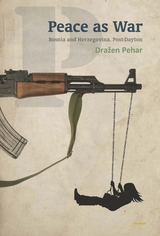 Peace as War: Bosnia-Herzegovina Post-Dayton
Drazen Pehar
Central European University Press, 2019 The book is about the peace implementation process in Bosnia-Herzegovina viewed, or interpreted reasonably, as a continuation of war by other means. Twenty years after the beginning of the Dayton peace accords, we need to summarize the results: the author shares the general agreement in public opinion, according to which the process is a failure. Pehar presents a broad, yet sufficiently detailed, view of the entire peace agreement implementation that preserves 'the state of war,' and thus encourages the war-prone attitudes in the parties to the agreement. He examines the political and narratological underpinnings to the process of the imposed international (predominantly USA) interpretation of the Dayton constitution and peace treaty as a whole. The key issue is the – perhaps only semi-consciously applied – divide ut imperes strategy. After nearly twenty years, the peace in document was not translated into a peace on the ground because, with regard to the key political and constitutional issues and attitudes, Bosnia remains a deeply divided society. The book concludes that the international supervision served a counter-purpose: instead of correcting the aberration and guarding the meaning that was originally accepted in the Dayton peace treaty, the supervision approved the aberration and imposed it as a new norm under the clout of 'the power of ultimate interpretation.'
|
|
